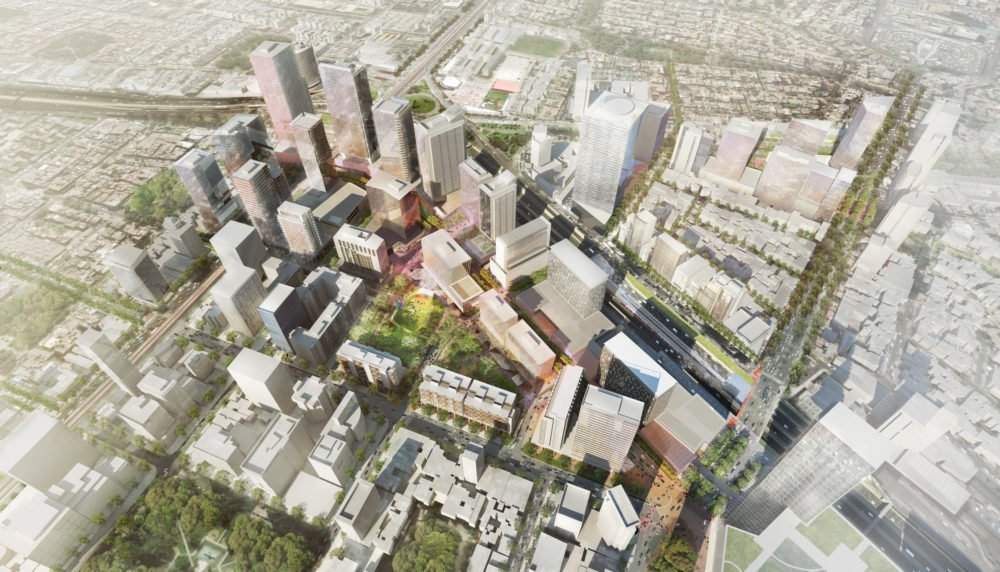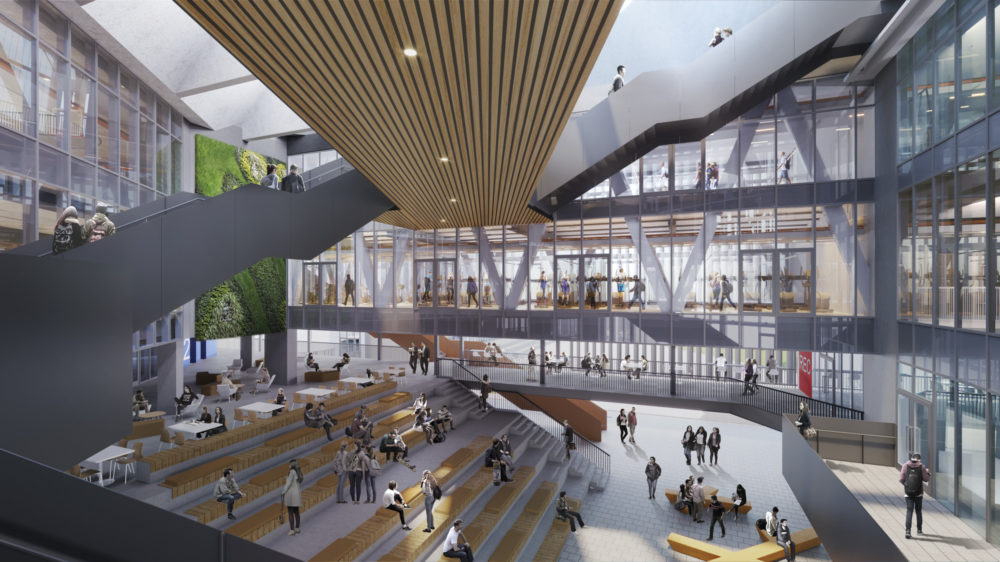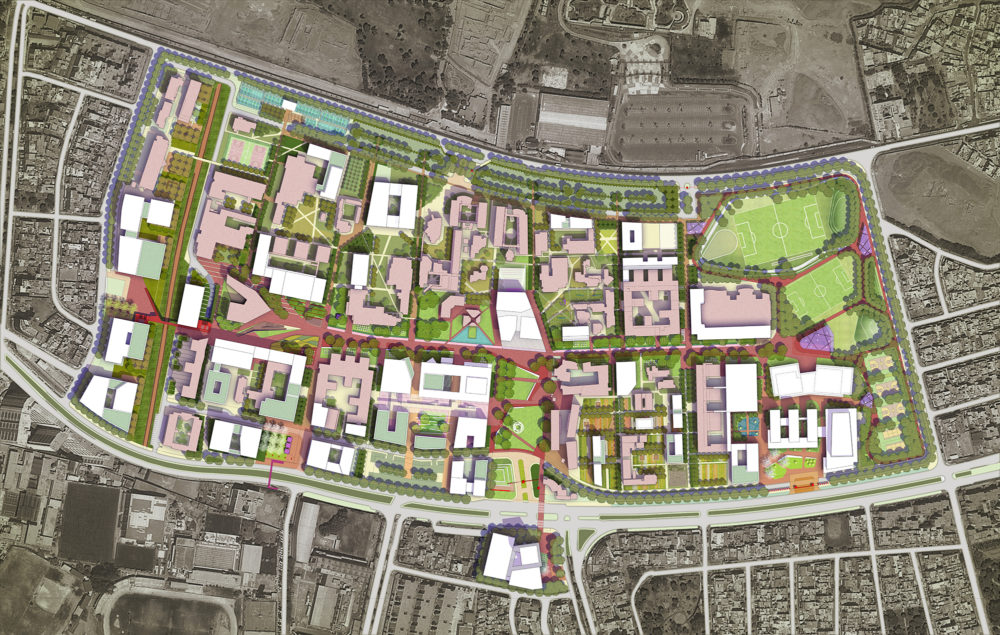A bold new planning and design approach in Chile, spurred by public engagement to catalyze the urban and ecological regeneration of Viña del Mar
Las Salinas
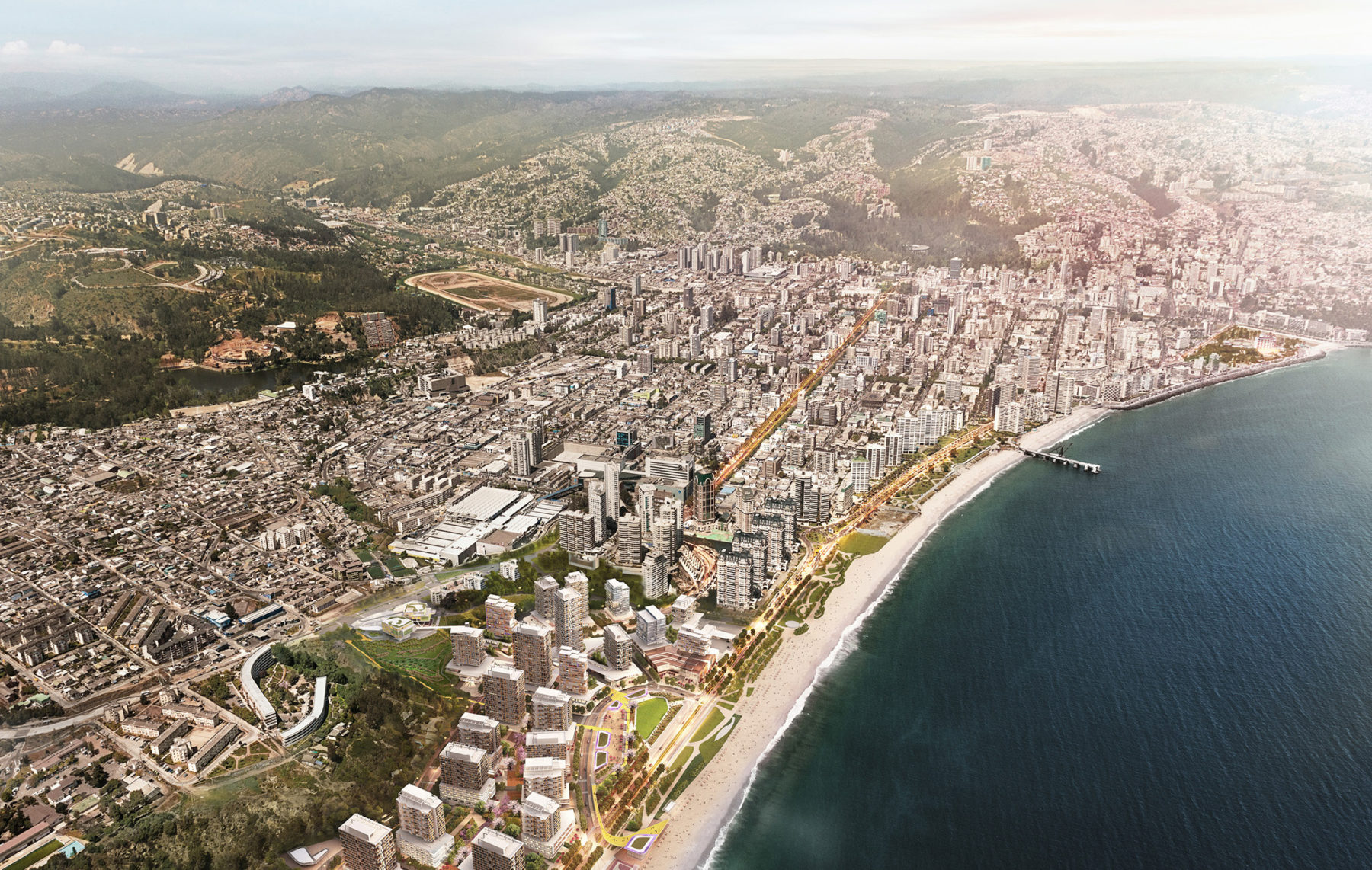
Las Salinas redefines development practices in Chile by transcending the boundaries of the site and revitalizing a brownfield condition into a 21st century sustainable district. The regeneration of the local ecology and re-engagement of the community to its seafront with new public spaces will have a lasting legacy in contemporary Chilean urbanism.
Las Salinas represents a bold new approach to planning and design in Chile, where the transformation of a brownfield site becomes the catalyst for the urban and ecological regeneration of Viña del Mar.
Originally planned as the extension of the 19th century Valparaiso metropolis, the tree-lined boulevards and formal parks of Viña gave rise to its fame as the Garden City of Chile. Yet, in recent decades the city has struggled to maintain the quality of life it once nurtured. The lack of attention to the city’s ecological infrastructure has led to a decline of its urban forest canopy and degradation of the native habitat on hillsides and ravines. Poor planning practices have created a car-dominated culture that has degraded the quality of the public realm, while single-use and inward-focused developments have impacted the vitality of neighborhoods.
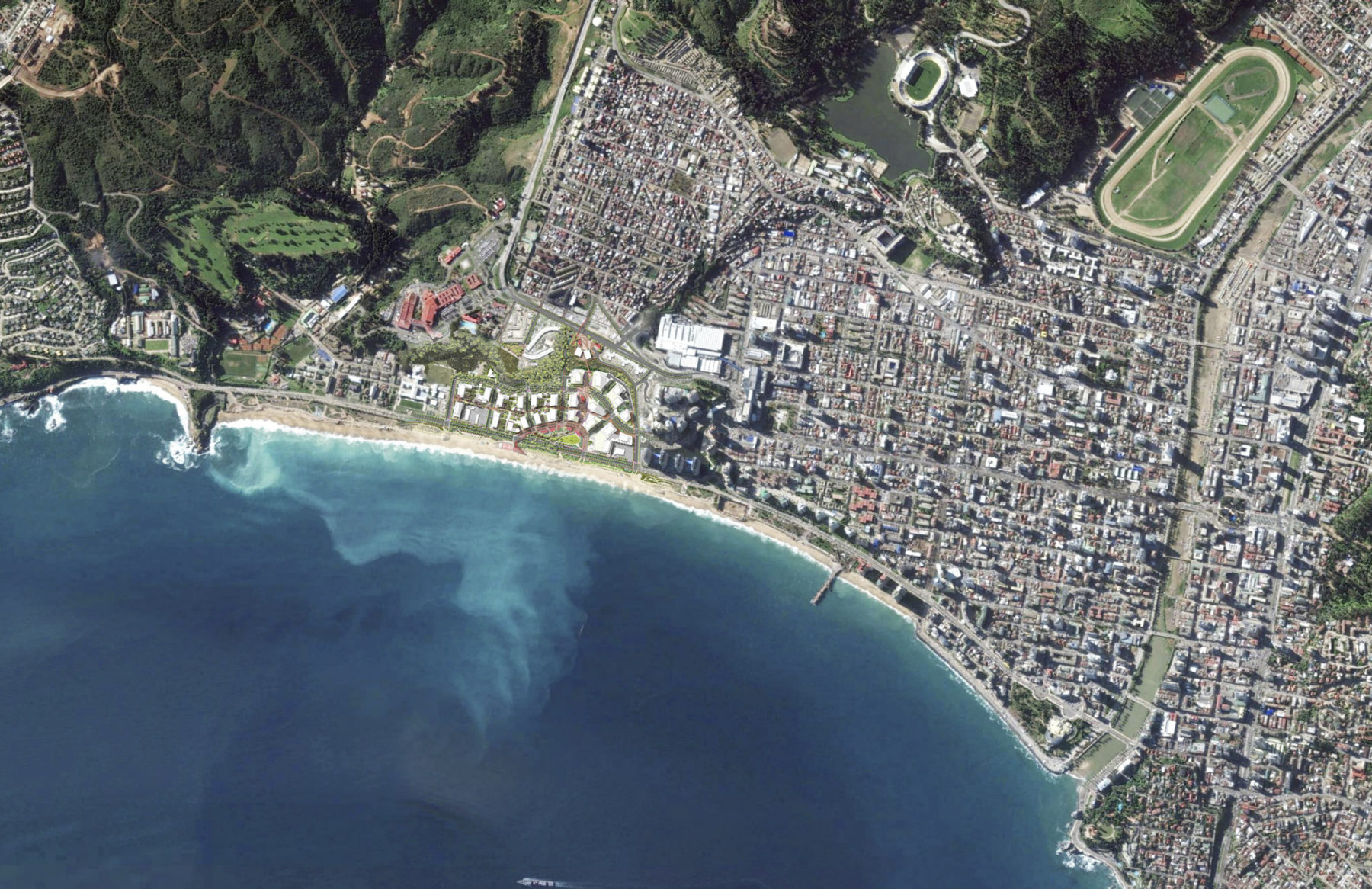
The site is not far from the heart of downtown and sits along a prime stretch of waterfront
Our ambition was to rethink development practices in the city and to reveal the true potential of Las Salinas to redefine Viña’s trajectory. Transcending the physical boundaries of the site, this vision seeks to restore the local ecology and re-engage the community to its seafront and public spaces. Through the collective efforts of the community, client, and design team, the framework represents a shared vision to regenerate the vitality of the city.
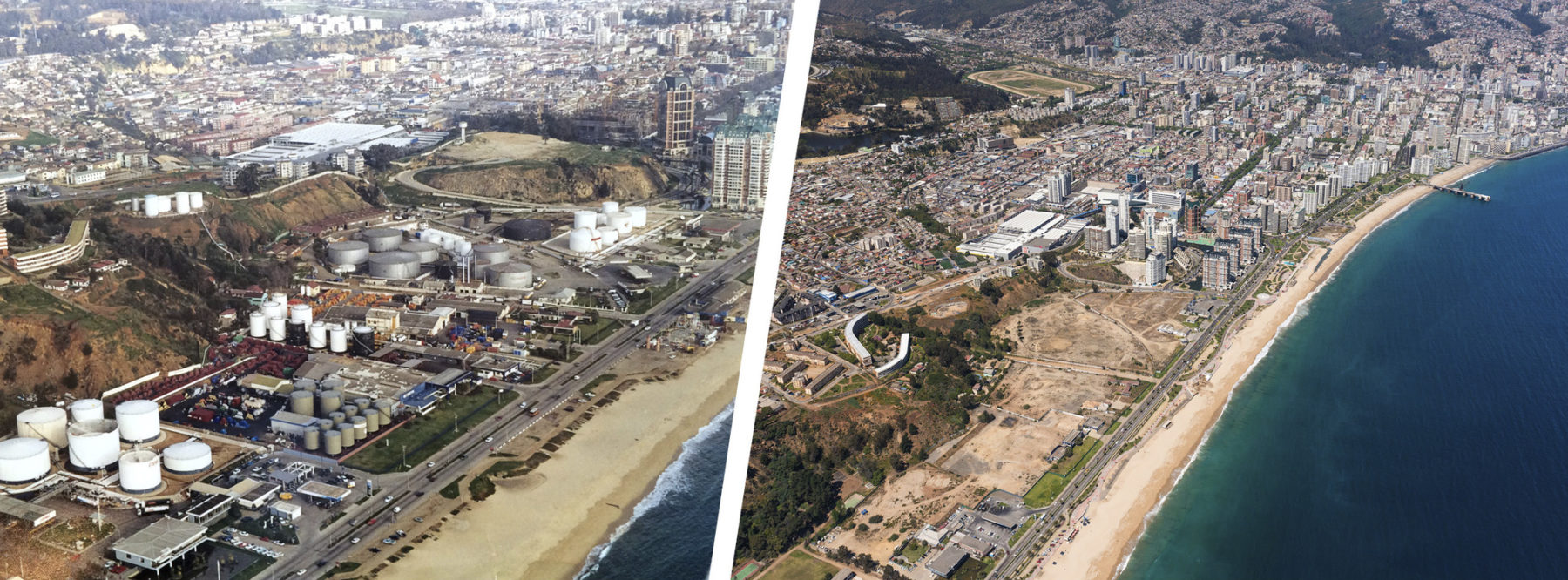
Transformation: before and after. Las Salinas is the third project in the world to have met or exceeded the v4 LEED ND Gold standard and the first in the Americas.
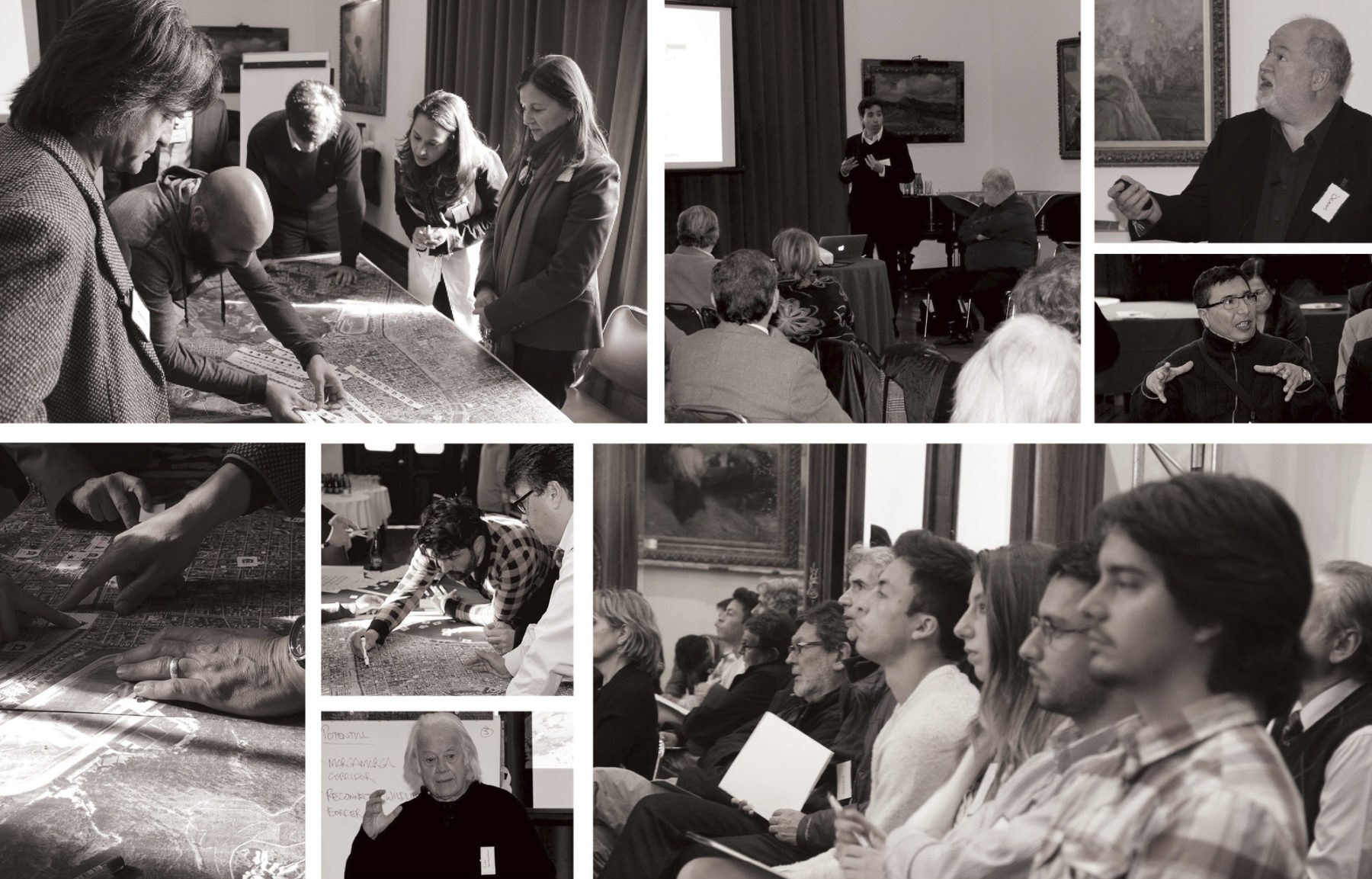
Through a series of Urban Dialogues, co-creation meetings that included activists, city officials, artists, academics etc, the design team exchanged ideas and engaged in systematic thinking on how to improve the quality of life in the city
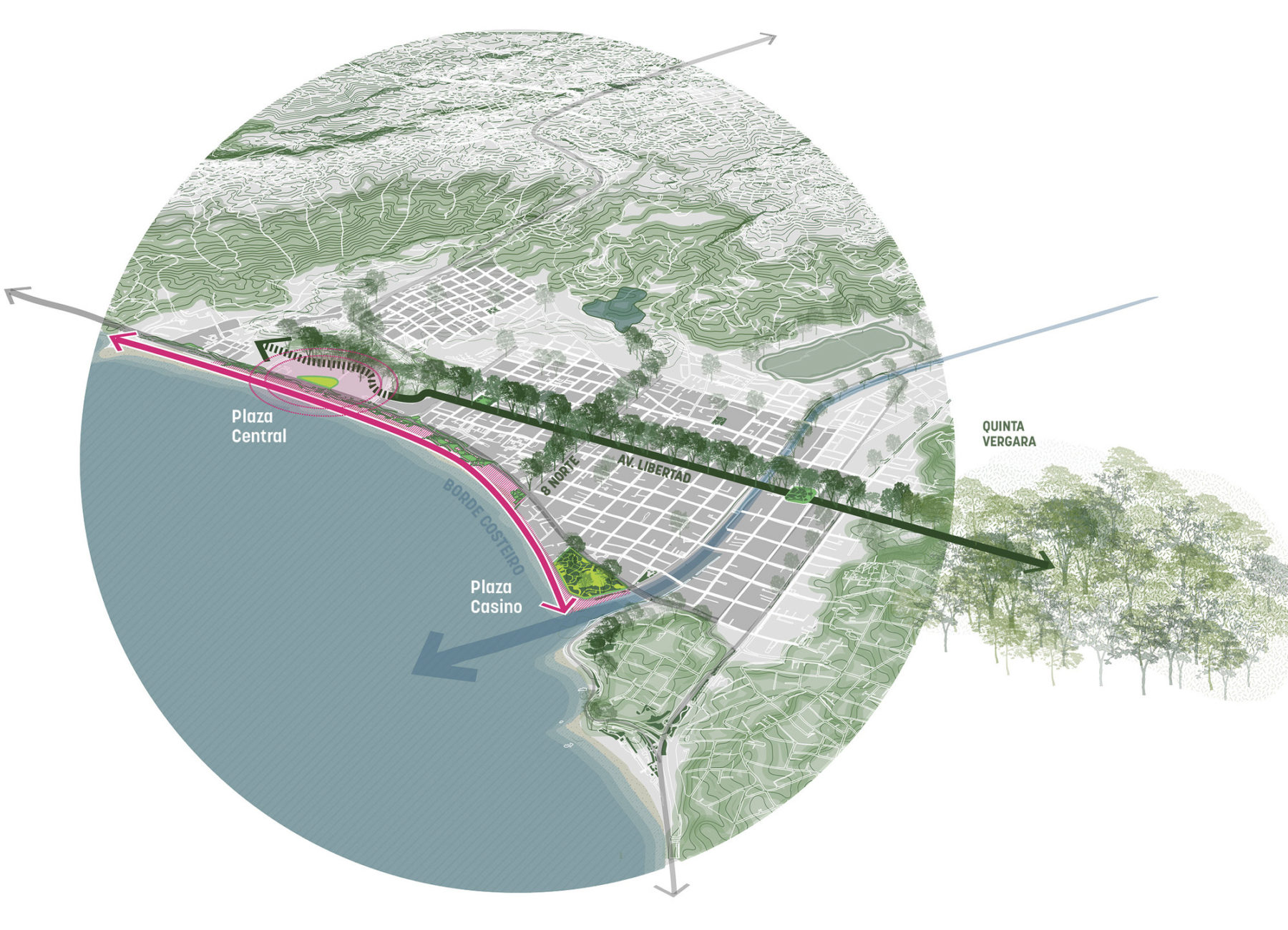
Site and city context
New connections through the site engage hillside communities that have been historically cut-off from the coast. At the hilltop, a Community Center and public elevator draws in the Santa Inés residents. With a focus on disadvantaged youth, its program includes recreation, job training, a library and flexible public spaces. At the seafront, the Central Park is a civic gesture to the city and is framed by cultural and public uses that promote greater social integration.
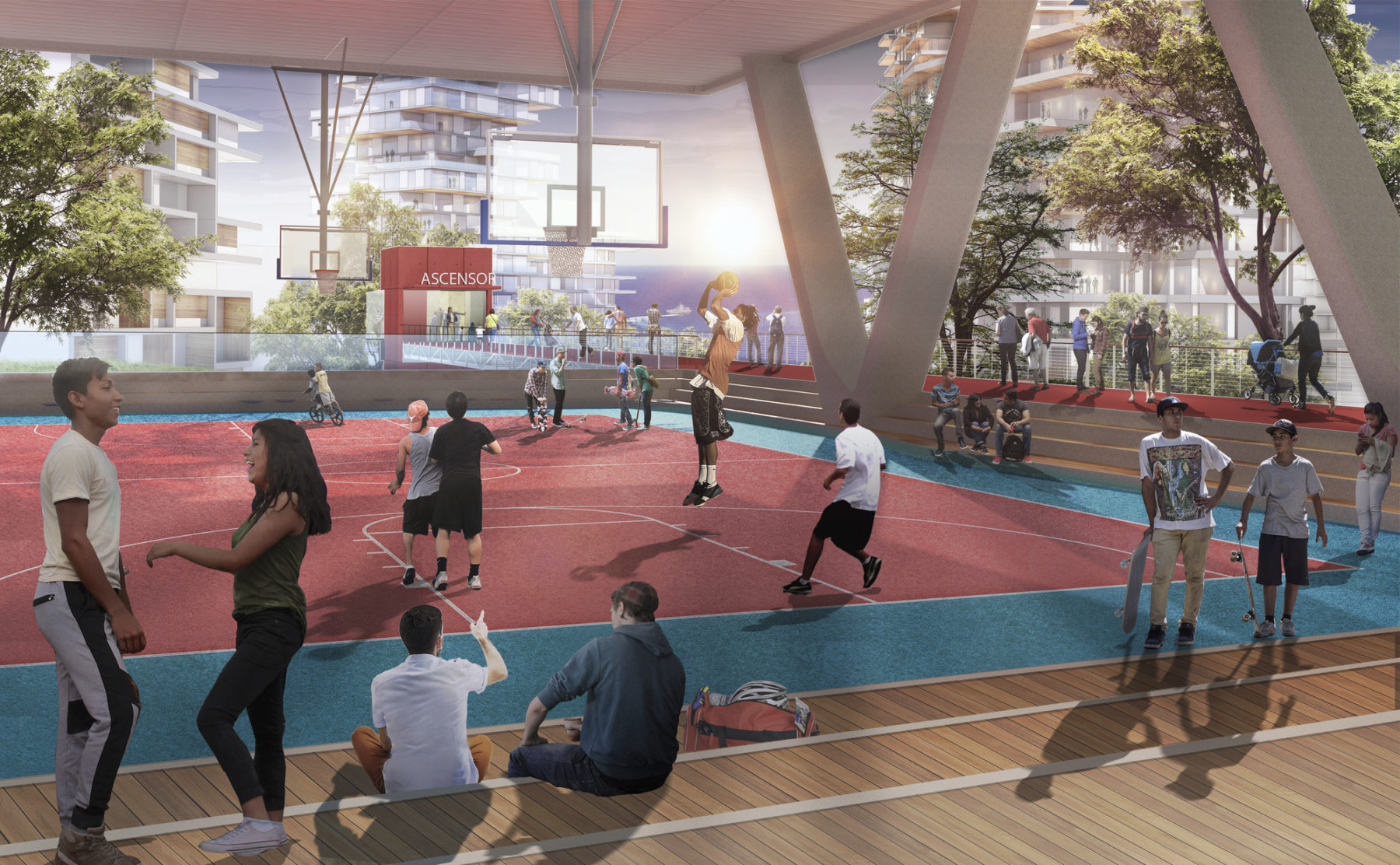
A new Community Center will serve the broader community with access to recreation amenities and other social spaces
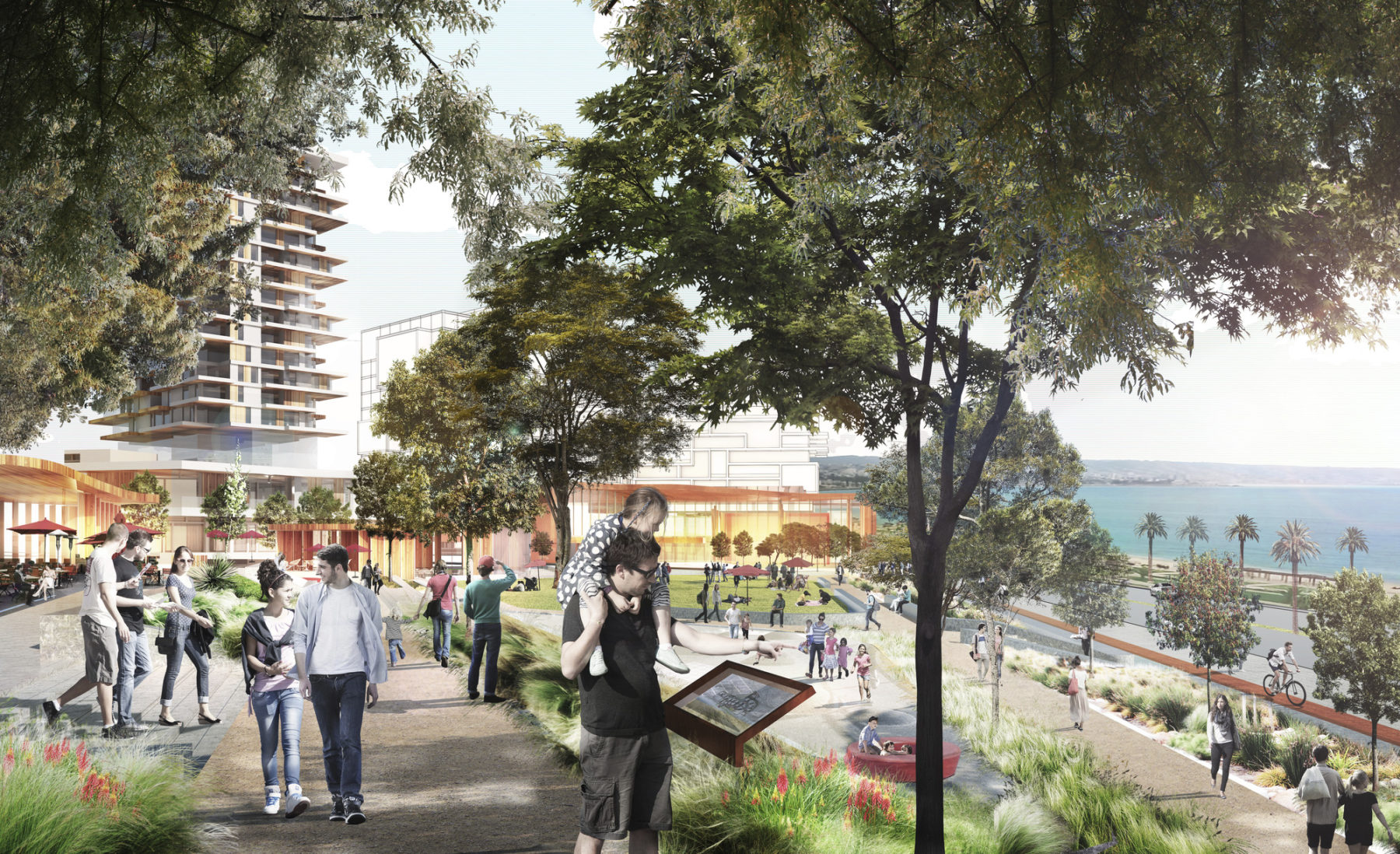
A Civic Gesture: The Central Park facing the Pacific Ocean is a civic gesture for the city and a return for the city and a return to Viña’s legacy of memorable public spaces
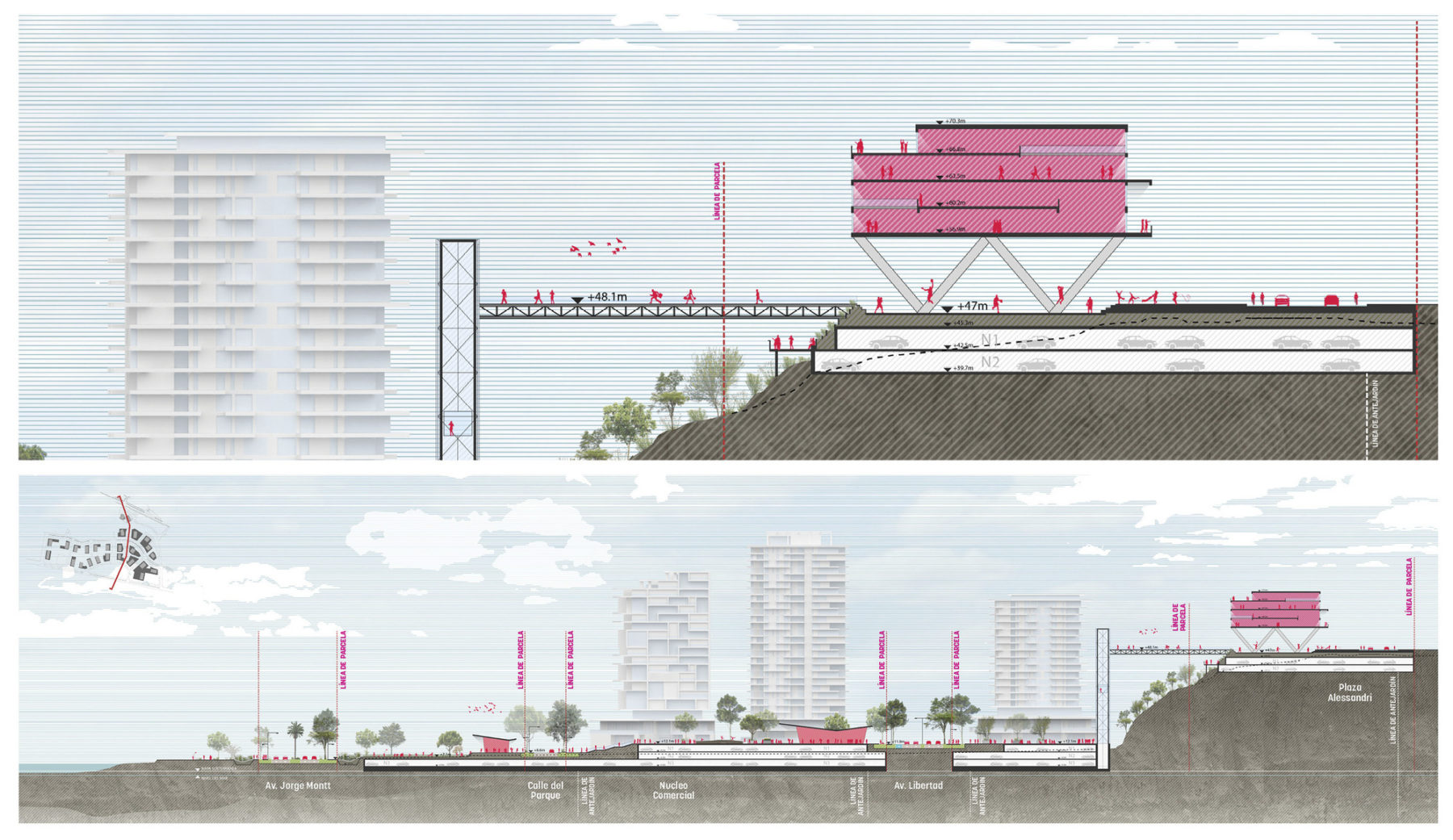
Engaging with Surrounding Communities: At the hilltop, a new Community Center connected to a public elevator provides a direct pedestrian linke to the sea, while creating a new activity hub for the Santa Inés Neighborhood
Envisioned as a mixed-use, porous and sustainable neighborhood, compact city blocks with a fully accessible and vibrant public realm will reduce the city’s reliance on private transportation. Civic, cultural, residential, retail, office and educational uses underpin a holistic community. At the ground-level, a wide range of active uses provide a rich urban and pedestrian experience.
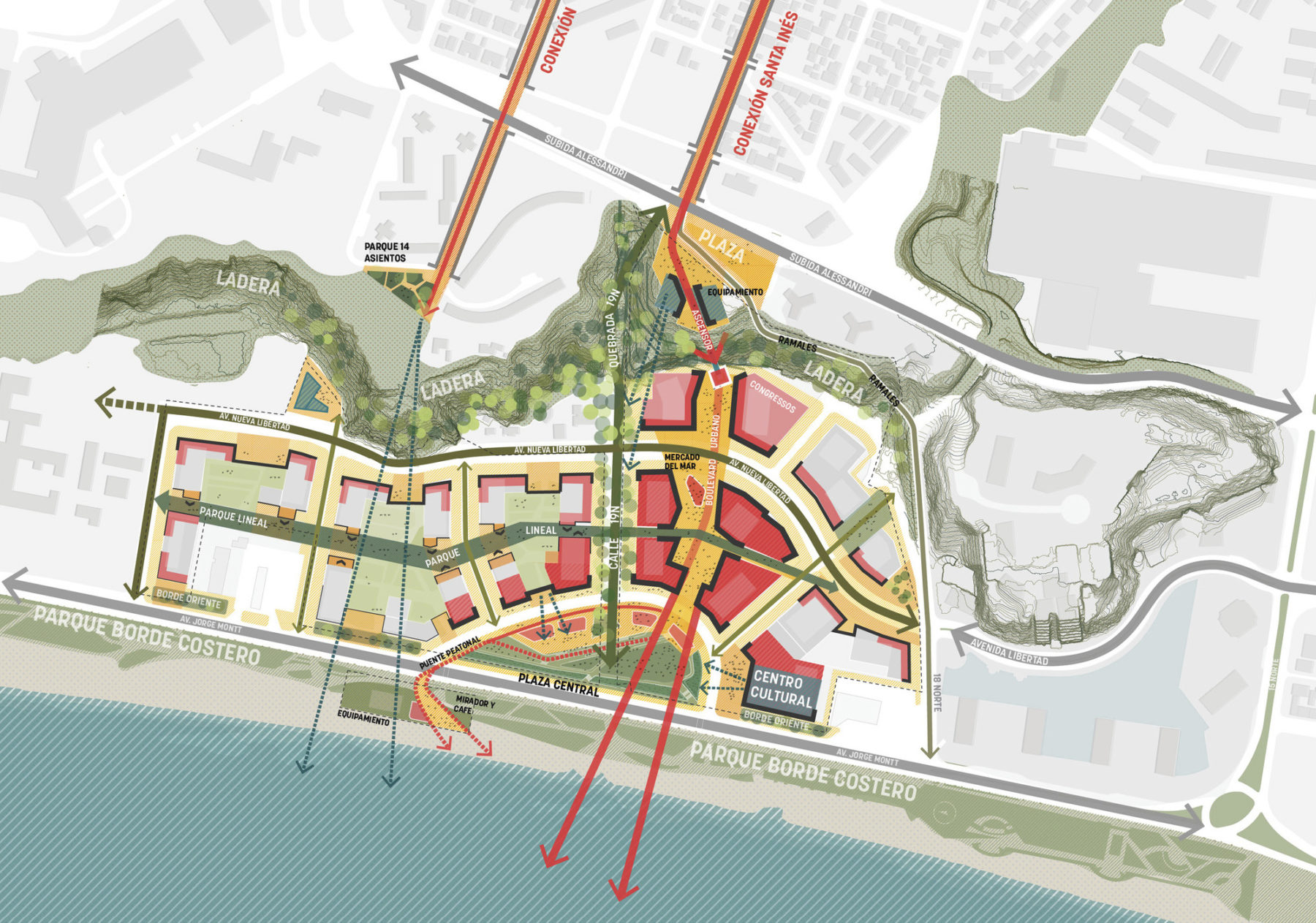
The framework creates new connections to the sea, re-engaging hillside neighborhoods that have historically been cut-off from the coast
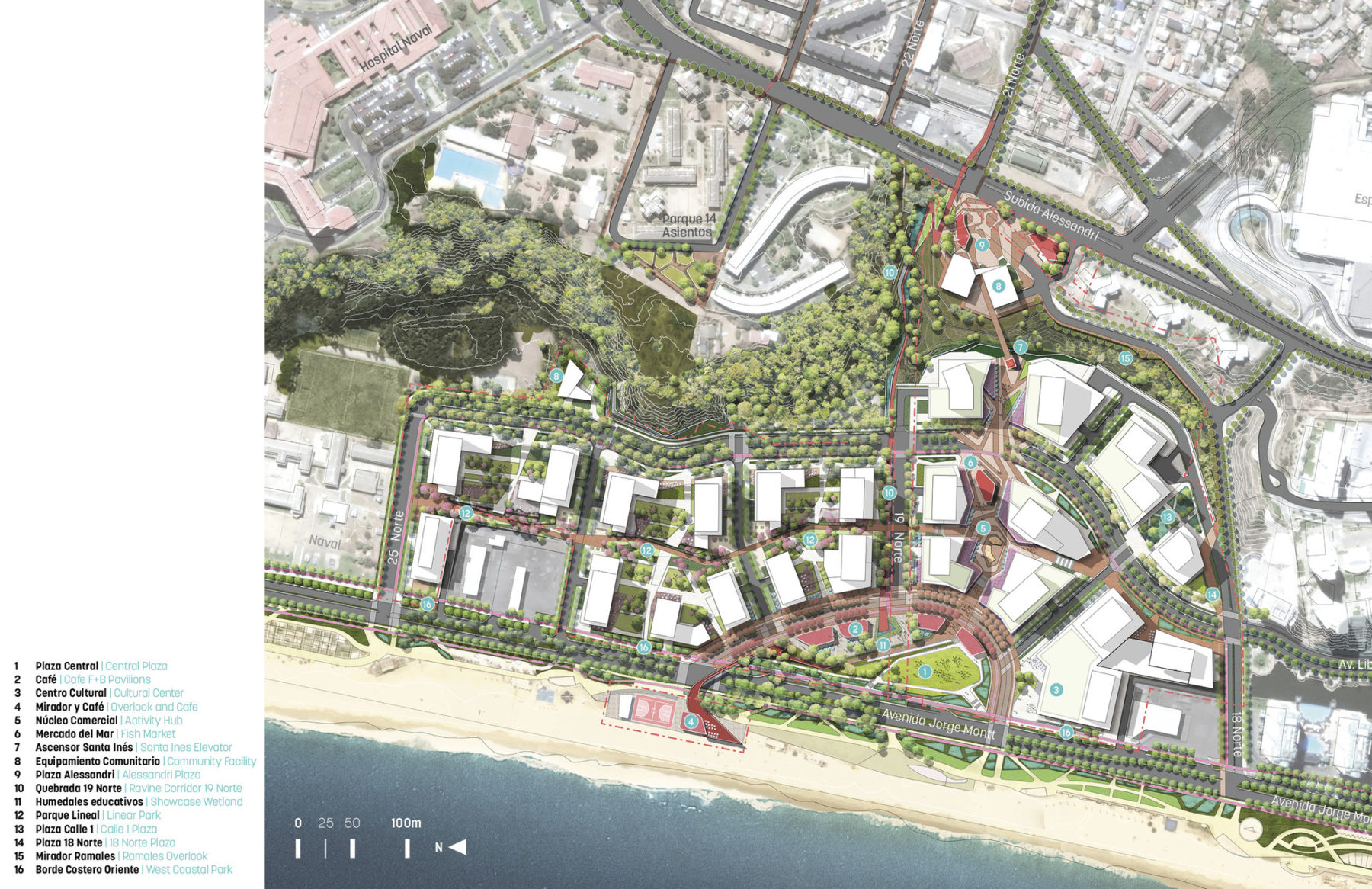
A verdant and functional public realm network ties together the district and its urban context
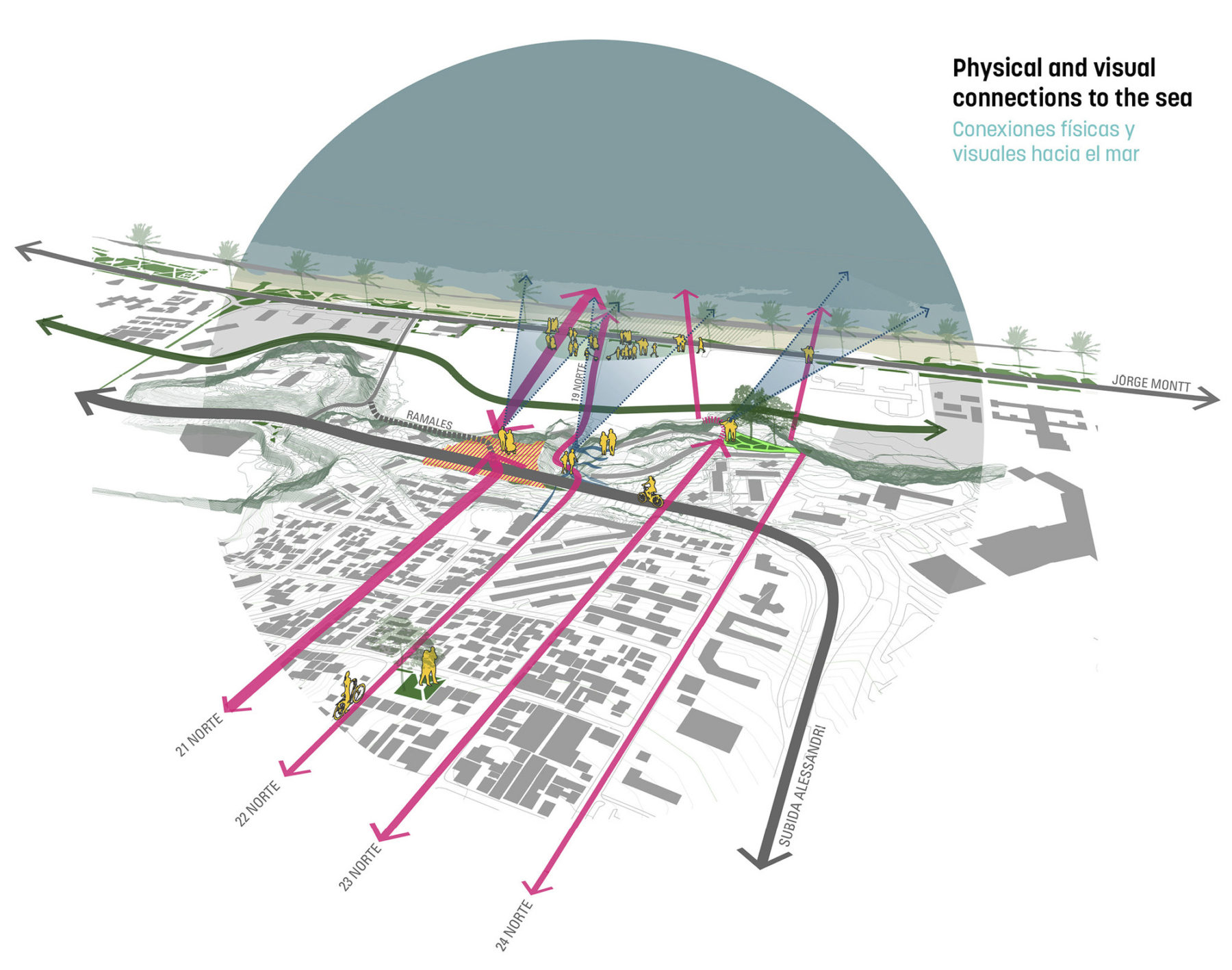
Visual and physical connections from the inland communities to the sea are a key driver for the plan
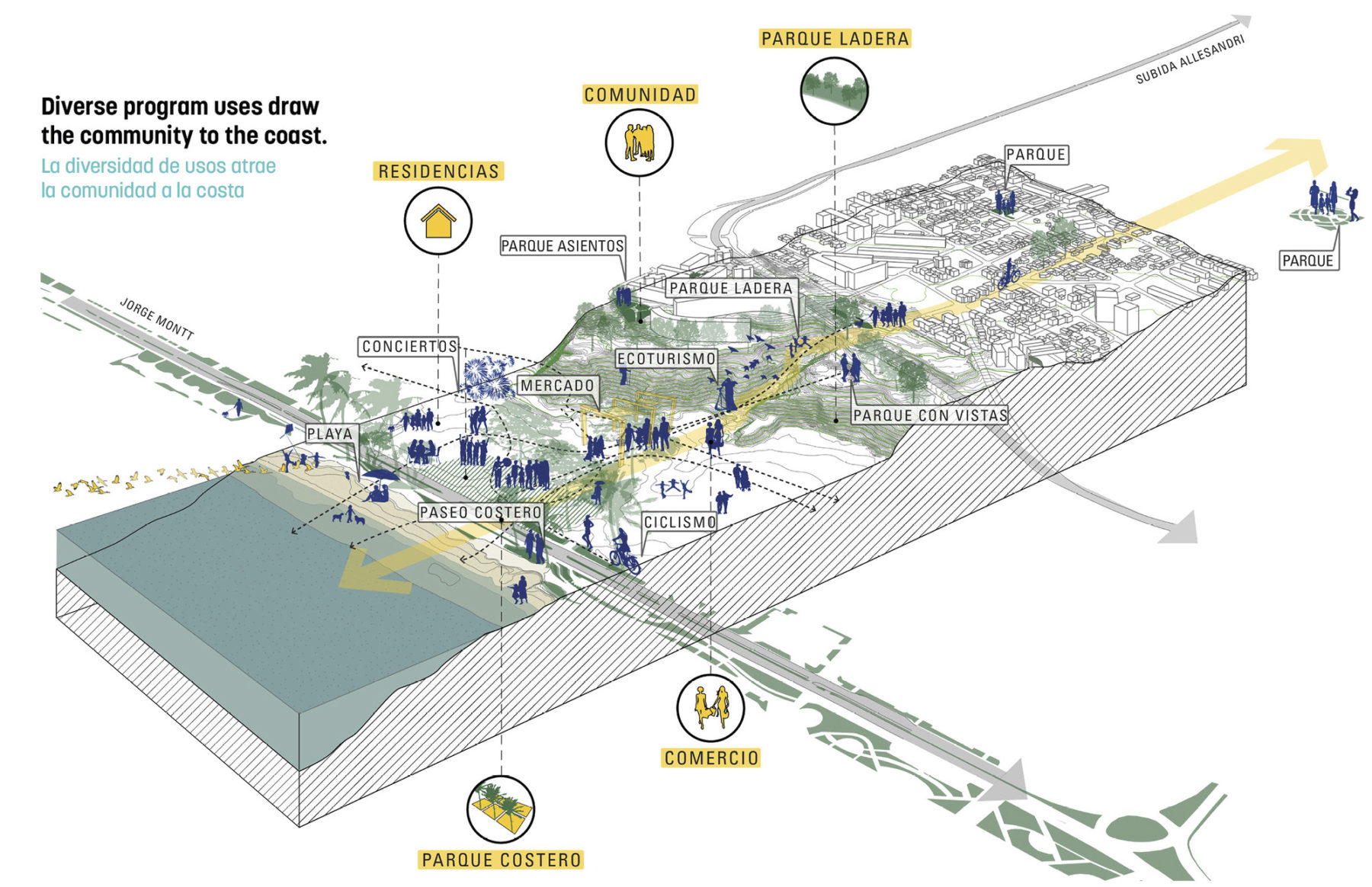
Diverse program uses draw the community to the coast
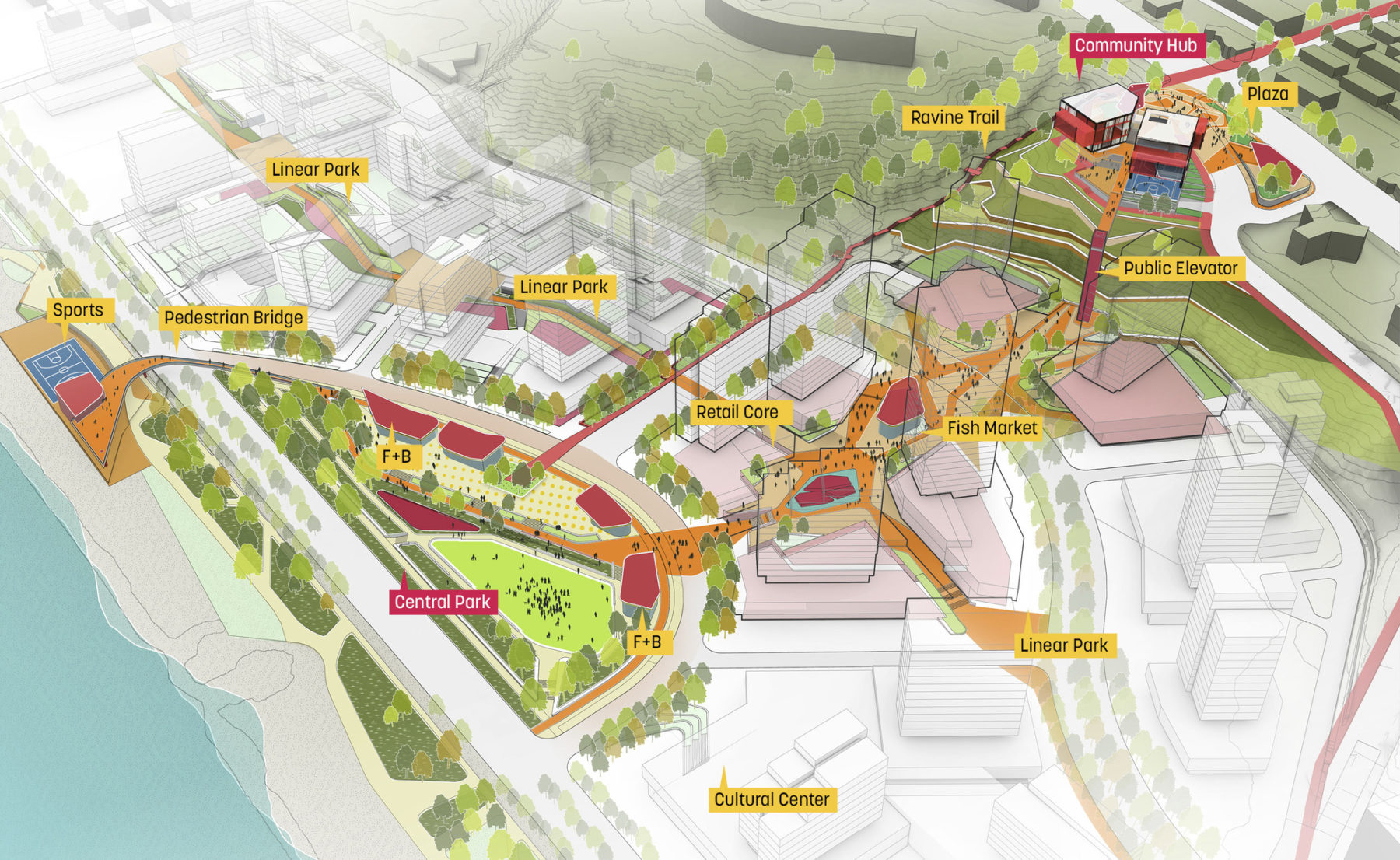
A fully accessible and interconnected public realm network promotes greater social integration among Viñamarinos. A pedestrian spine and regenerated ravine trail draws the Santa Inés community to a new public park on the Pacific Ocean coastline.
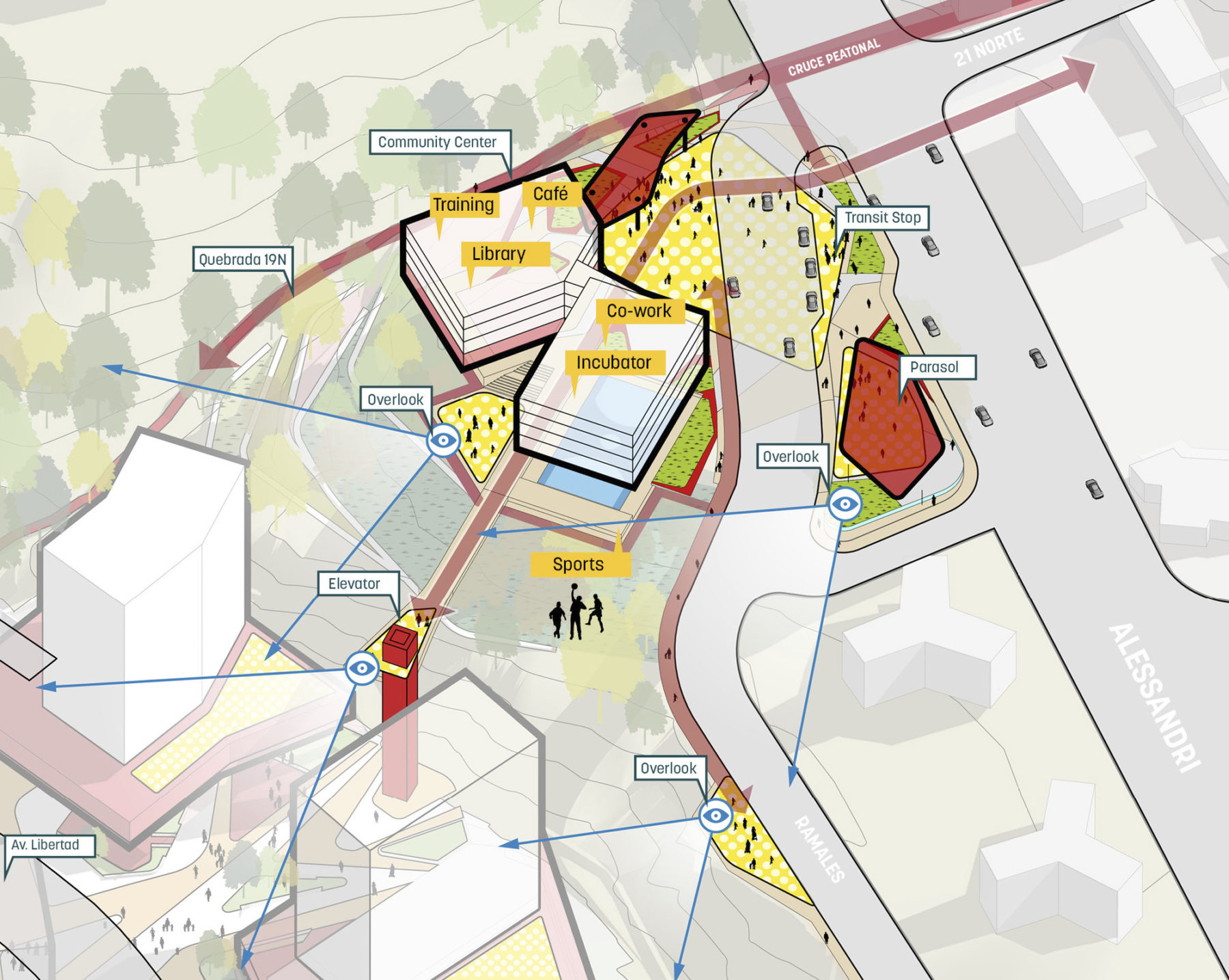
A network of verdant public spaces
The framework creates new connections to the sea, re-engaging hillside neighborhoods that have historically been cut-off from the coast
A verdant and functional public realm network ties together the district and its urban context
Visual and physical connections from the inland communities to the sea are a key driver for the plan
Diverse program uses draw the community to the coast
A fully accessible and interconnected public realm network promotes greater social integration among Viñamarinos. A pedestrian spine and regenerated ravine trail draws the Santa Inés community to a new public park on the Pacific Ocean coastline.
A network of verdant public spaces
Looking to nature for inspiration and a sustainable vision for the future, in depth research of the Chilean coastal landscape informed the regenerative approach to the site’s landscape infrastructure and essential ecosystem services. This multi-layered approach to form and function supports the overall connectivity and resilience of site systems which in turn regulate stormwater, nutrients, carbon, microclimate, pollination and species dispersal.
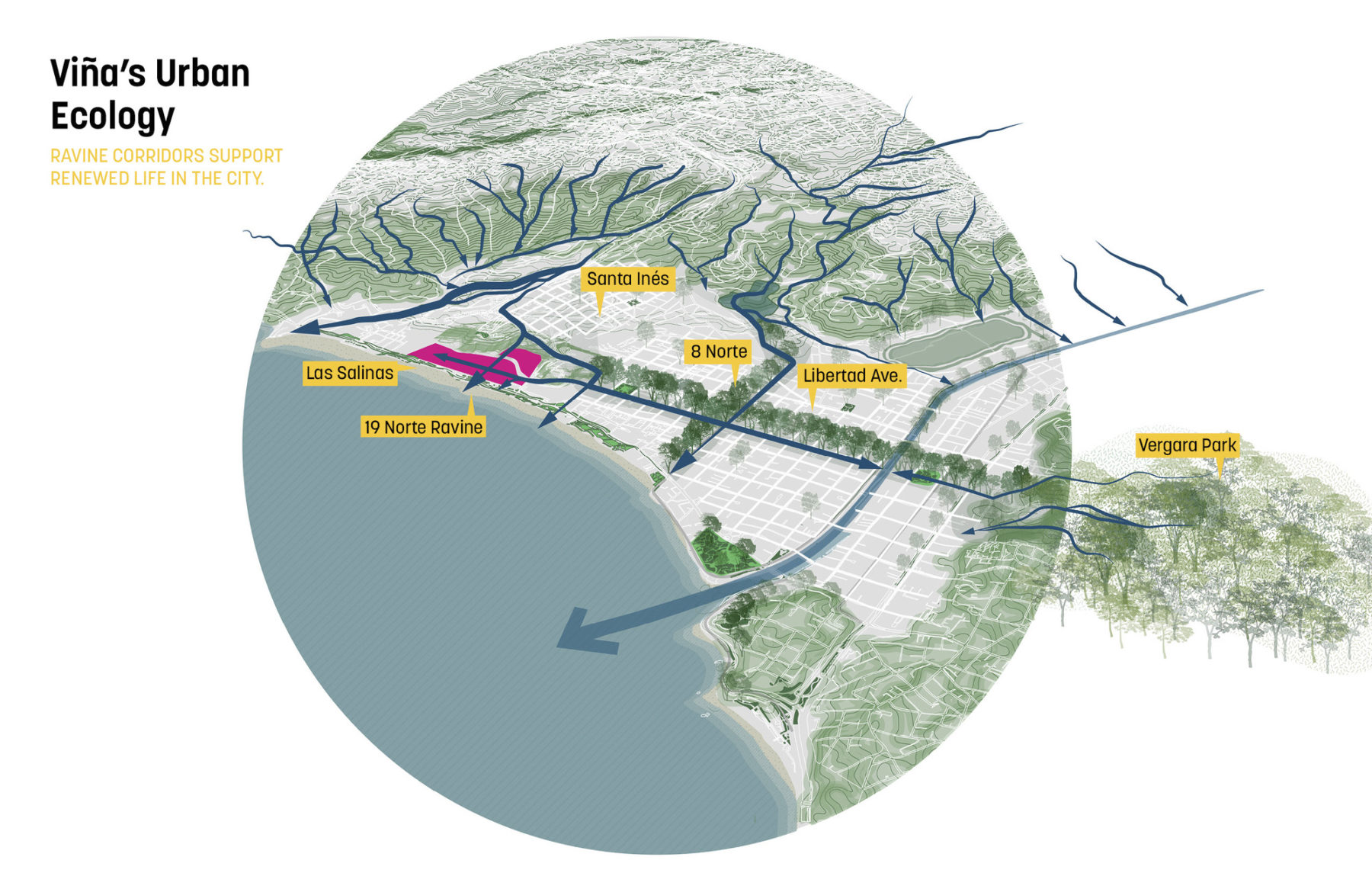
Largely ignored by recent development, the deterioration of ravines and river corridors have undermined the historic garden city quality of Viña. At Las Salinas, the 19N ravine presents a unique regenerative opportunity.
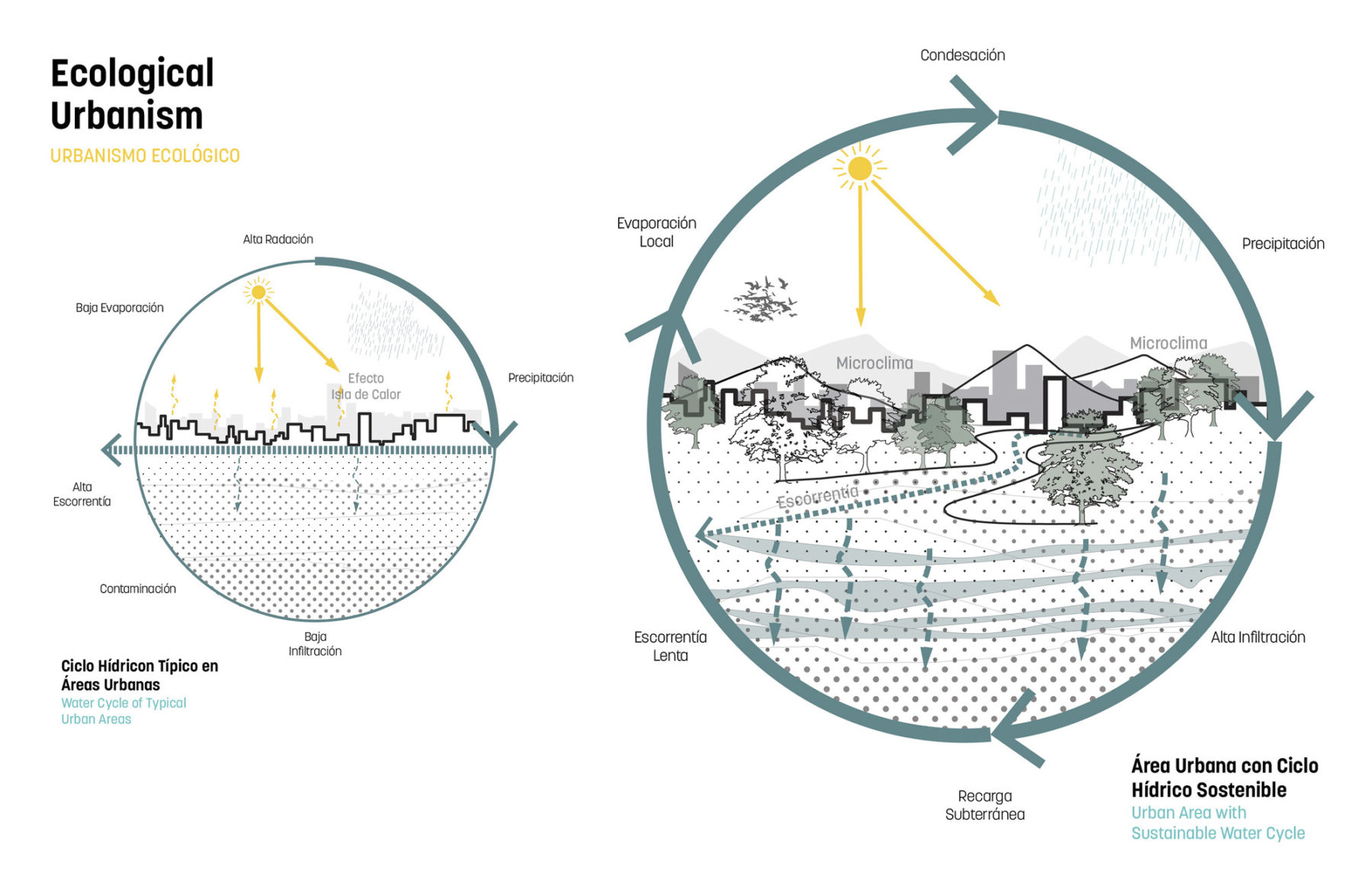
Ecological urbanism
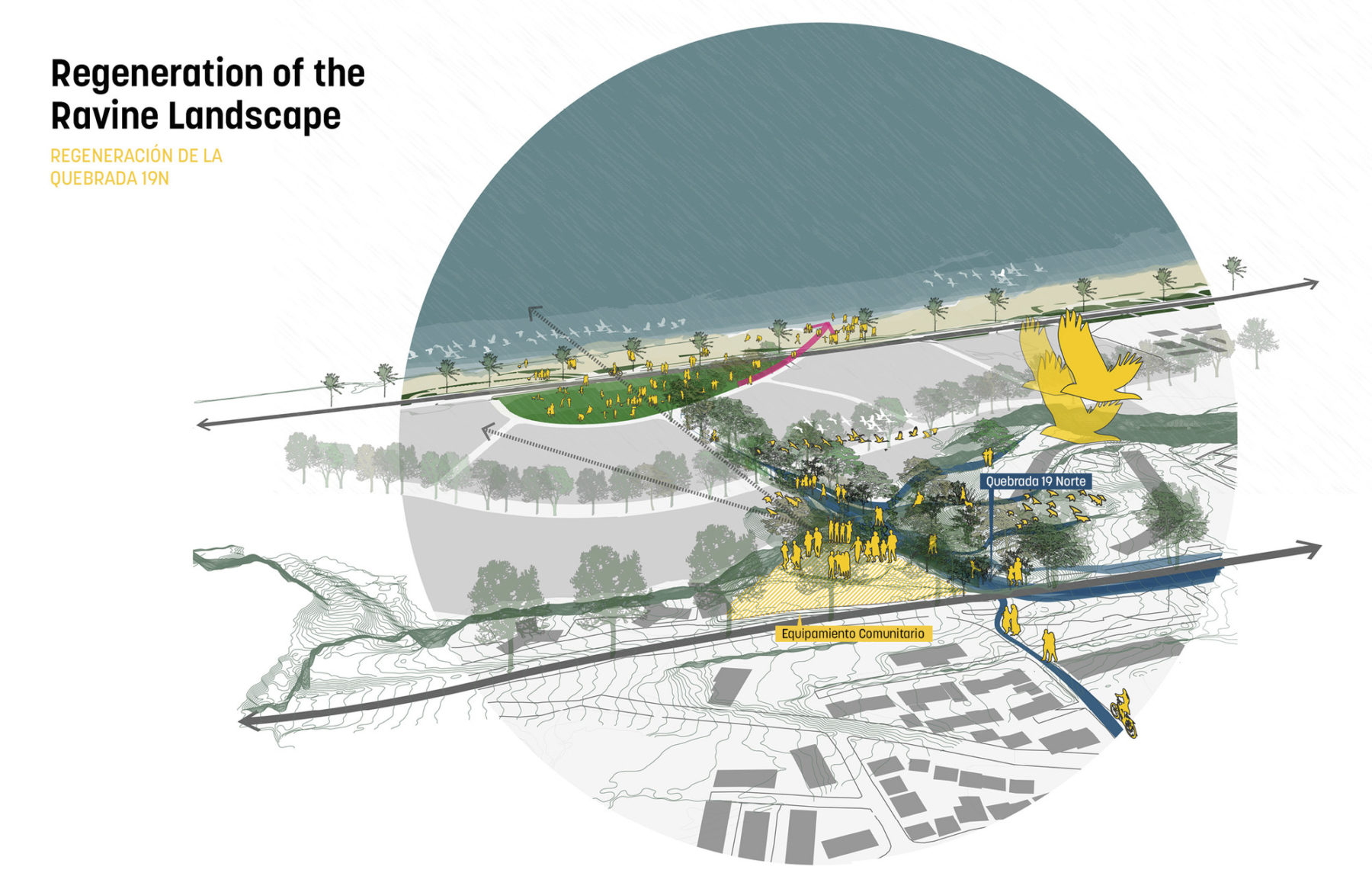
Regeneration of the ravine landscape

The regenerated 19 Norte ravine and community path restores a vital ecological system at the site while showcasing the benefits of a working landscape
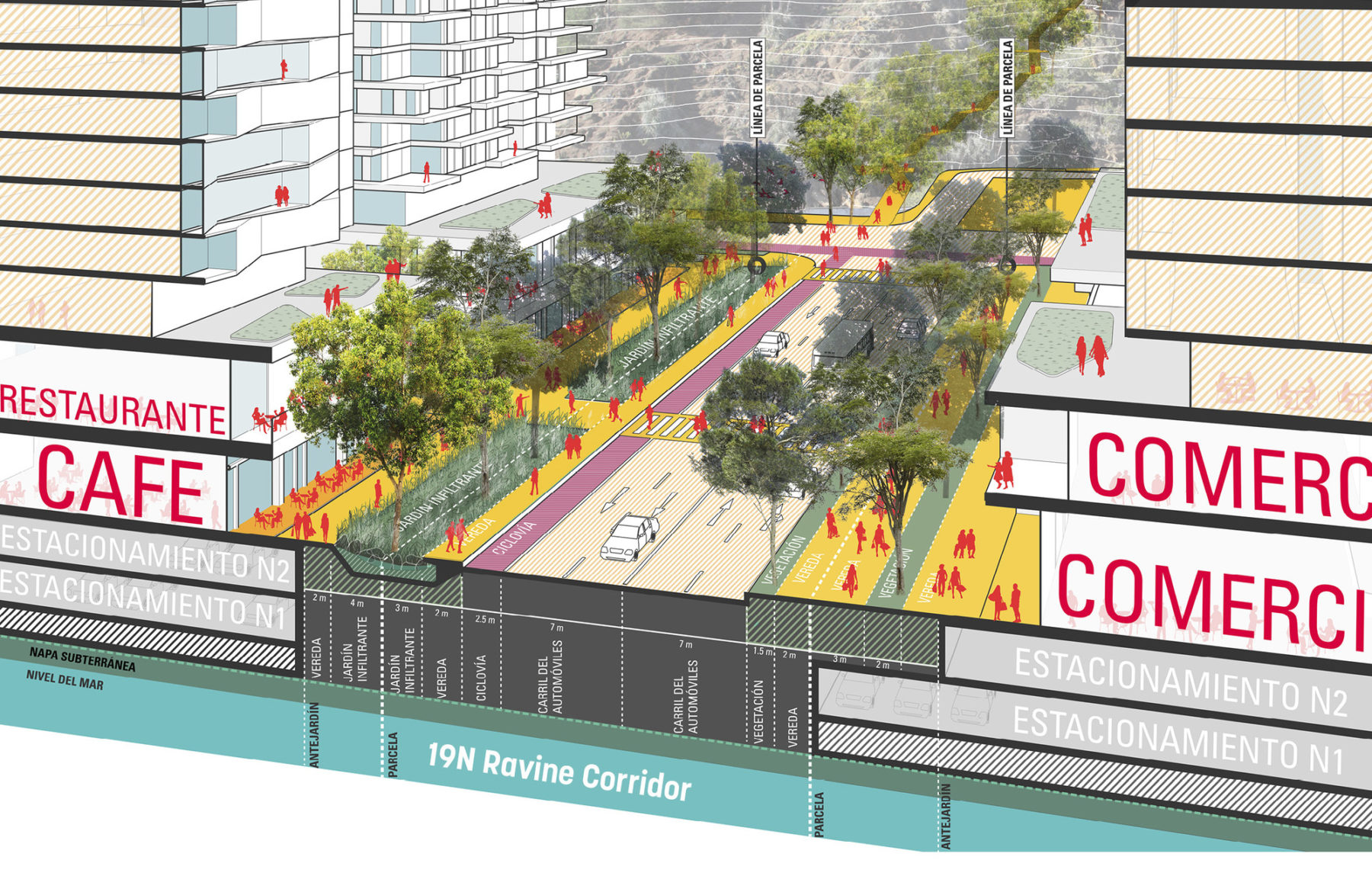
The regeneration of the ravine corridor extends through the neighborhood street and brings the energy of the Ladera (hillside) to the heart of the community
Largely ignored by recent development, the deterioration of ravines and river corridors have undermined the historic garden city quality of Viña. At Las Salinas, the 19N ravine presents a unique regenerative opportunity.
Ecological urbanism
Regeneration of the ravine landscape
The regenerated 19 Norte ravine and community path restores a vital ecological system at the site while showcasing the benefits of a working landscape
The regeneration of the ravine corridor extends through the neighborhood street and brings the energy of the Ladera (hillside) to the heart of the community
We enhanced the hillside landscape and leveraged the built environment as a rich zone of ecological activity. Shifting away from the typically limited selection of species used in urban landscapes, Las Salinas will incorporate a native, diverse and structurally complex planting palette that carefully responds to the microclimate and habitats created by the proposed development. The restoration of the 19N Ravine provides the blueprint for the careful integration of natural systems in urban development.
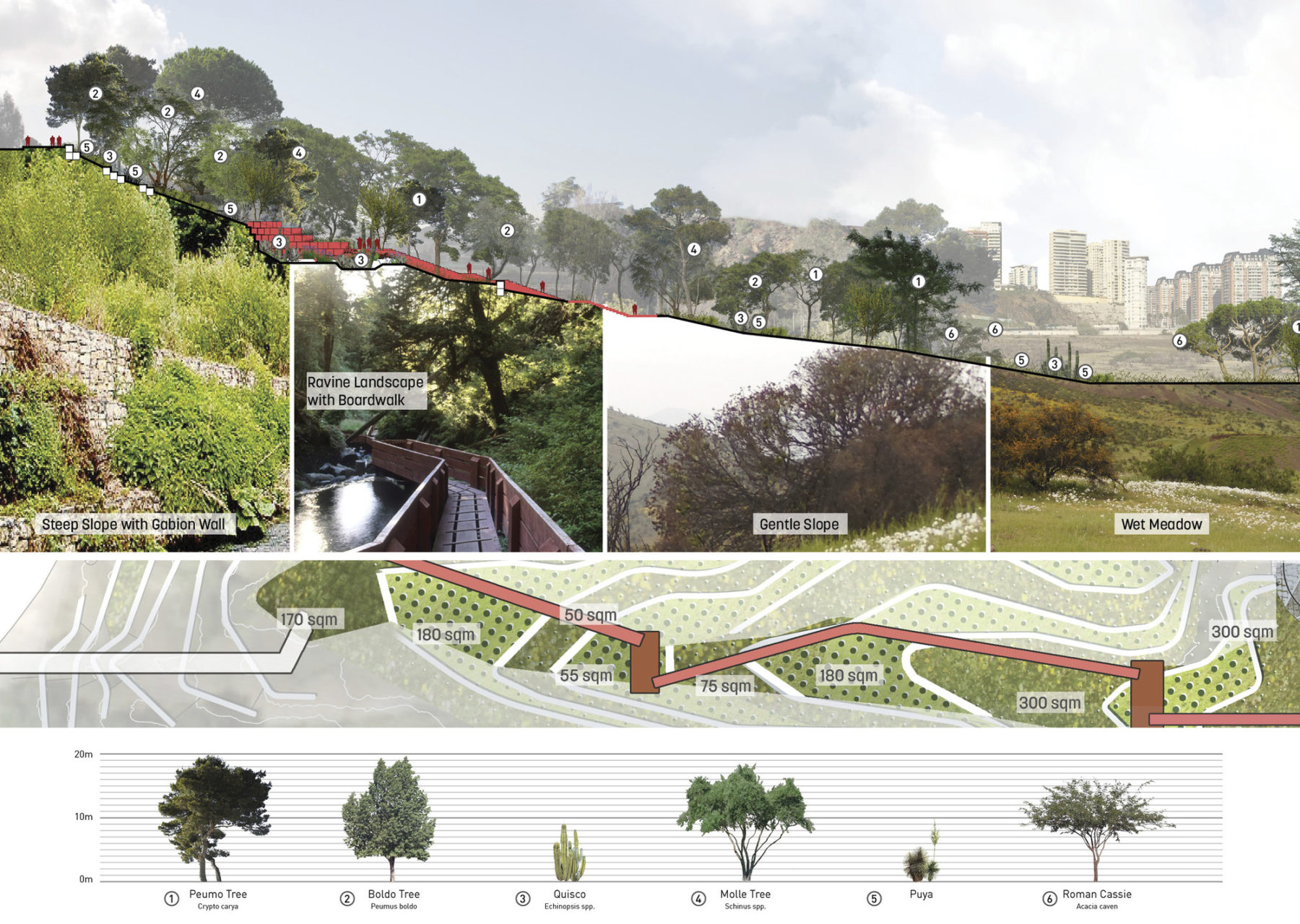
Diversity of vegetation
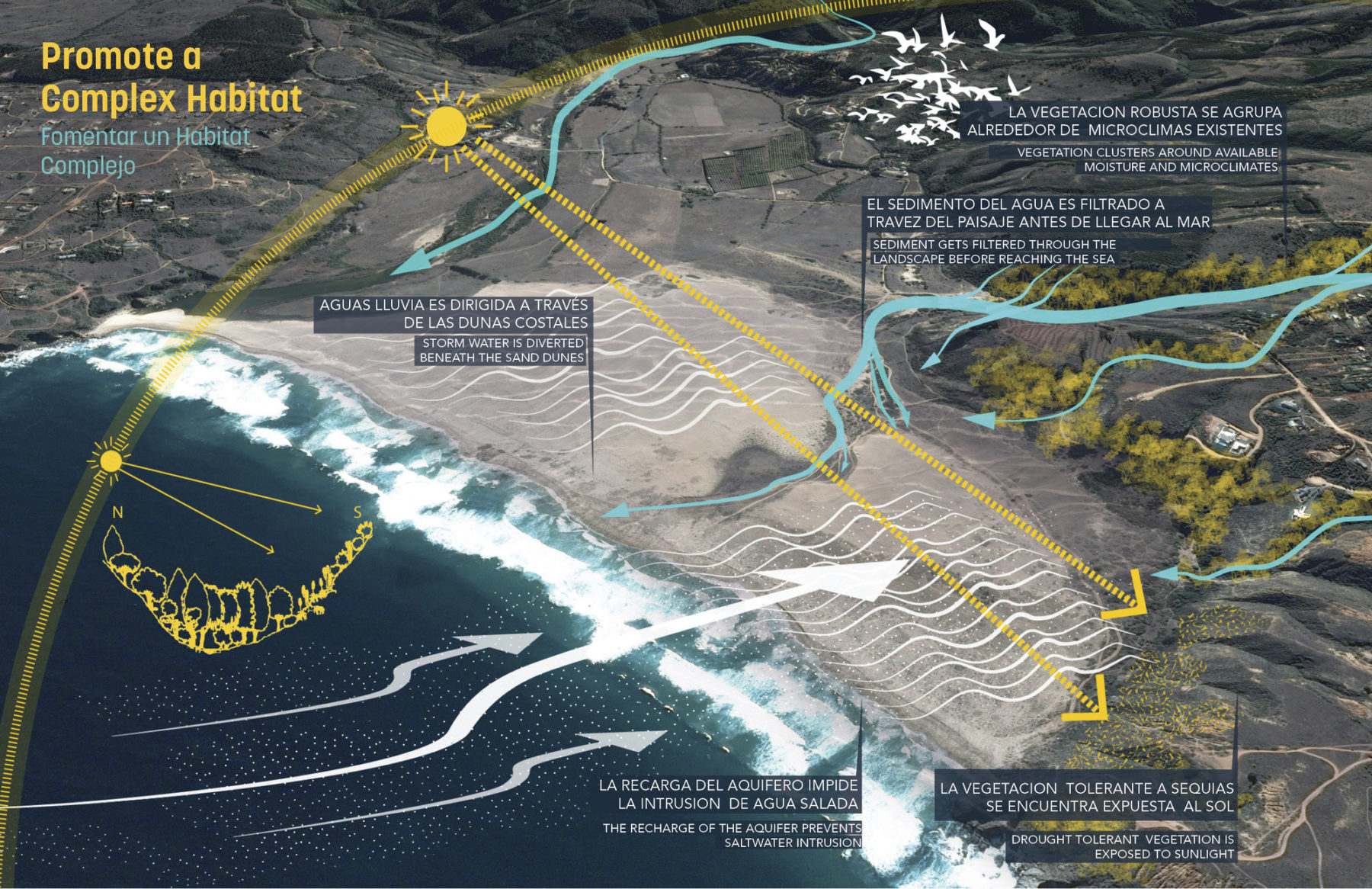
In-depth research of the Chilean coastal landscape informed strategies to regenerate the site’s ecological function and essential services
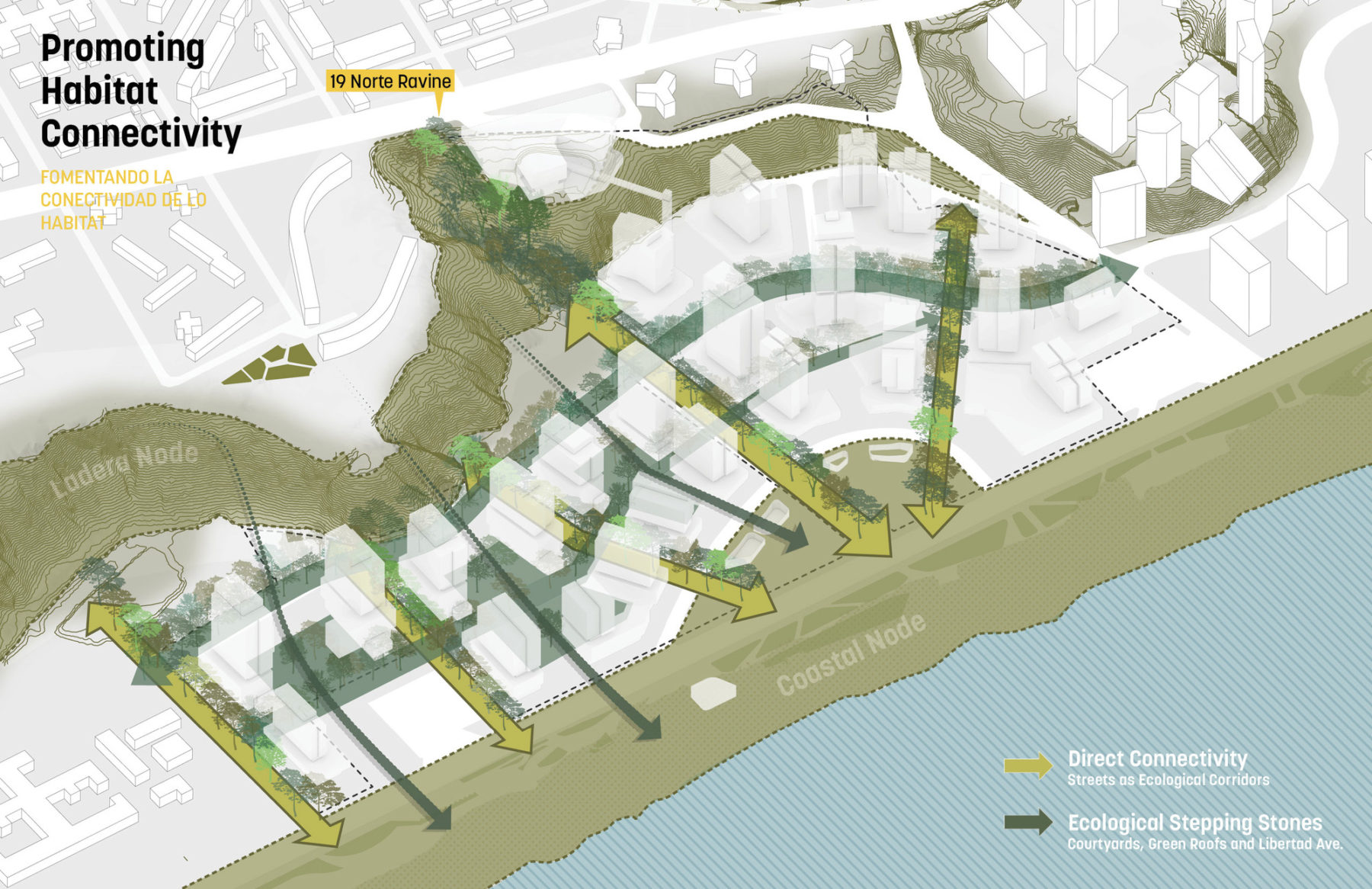
A system of Ecological Corridors and Stepping Stones provides strong connectivity between the escarpment and coastal habitat nodes
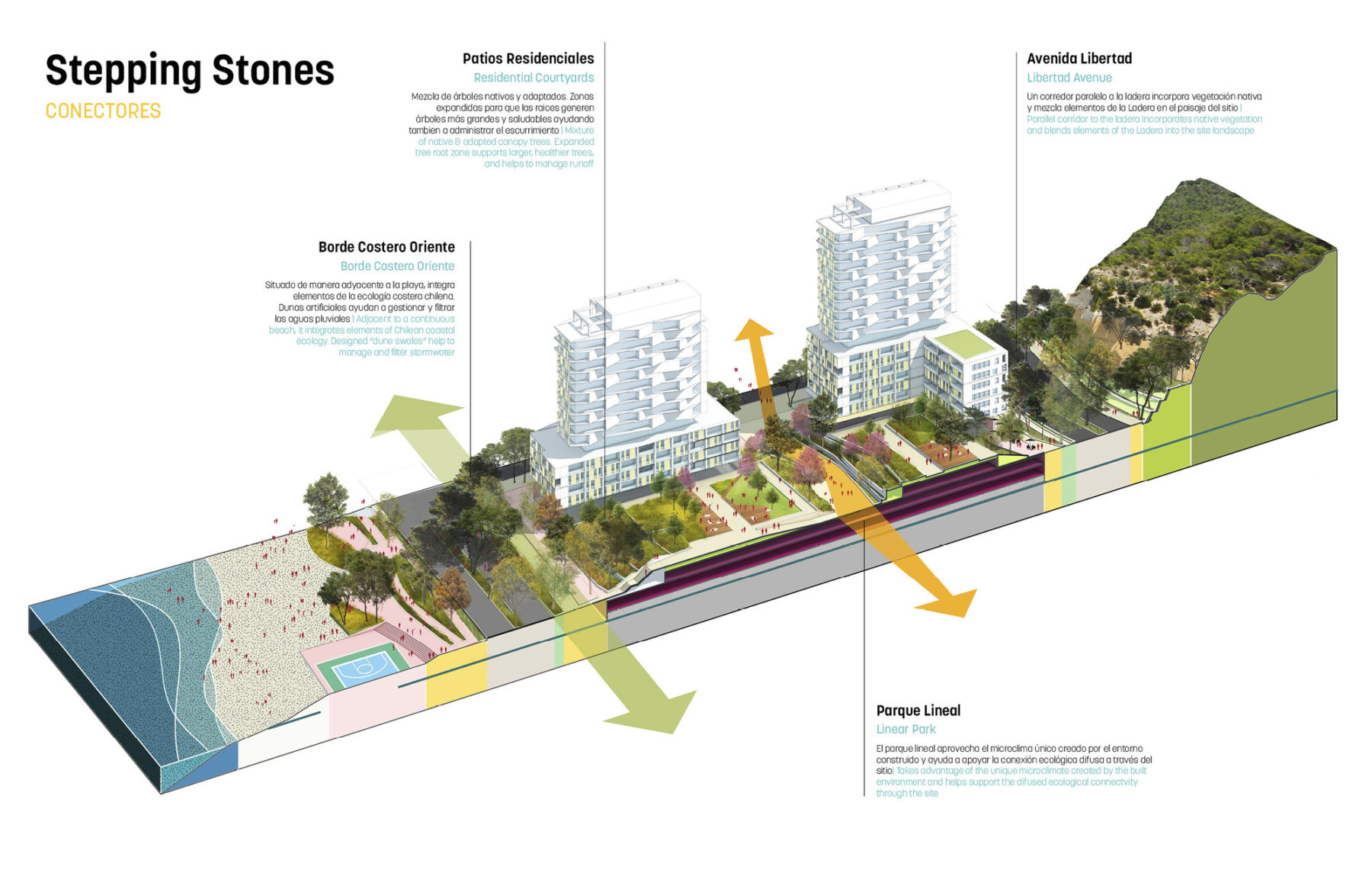
The Ladera (hillside) habitat is drawn into the neighborhood by a continuous tree canopy along Libertad Avenue. Green roofs and courtyards function as stepping stones between the escarpment and coastal landscape.
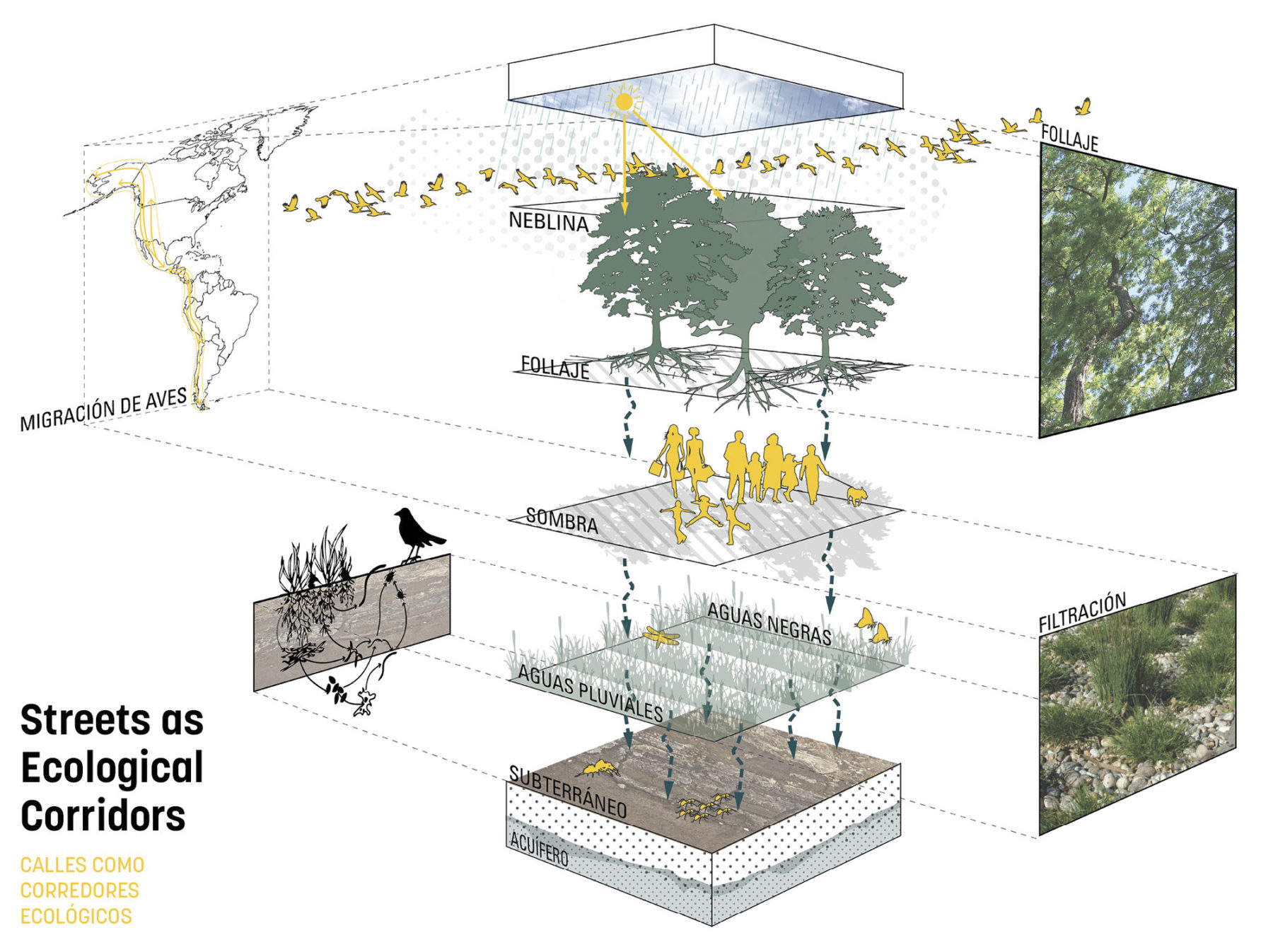
Streets as ecological corridors
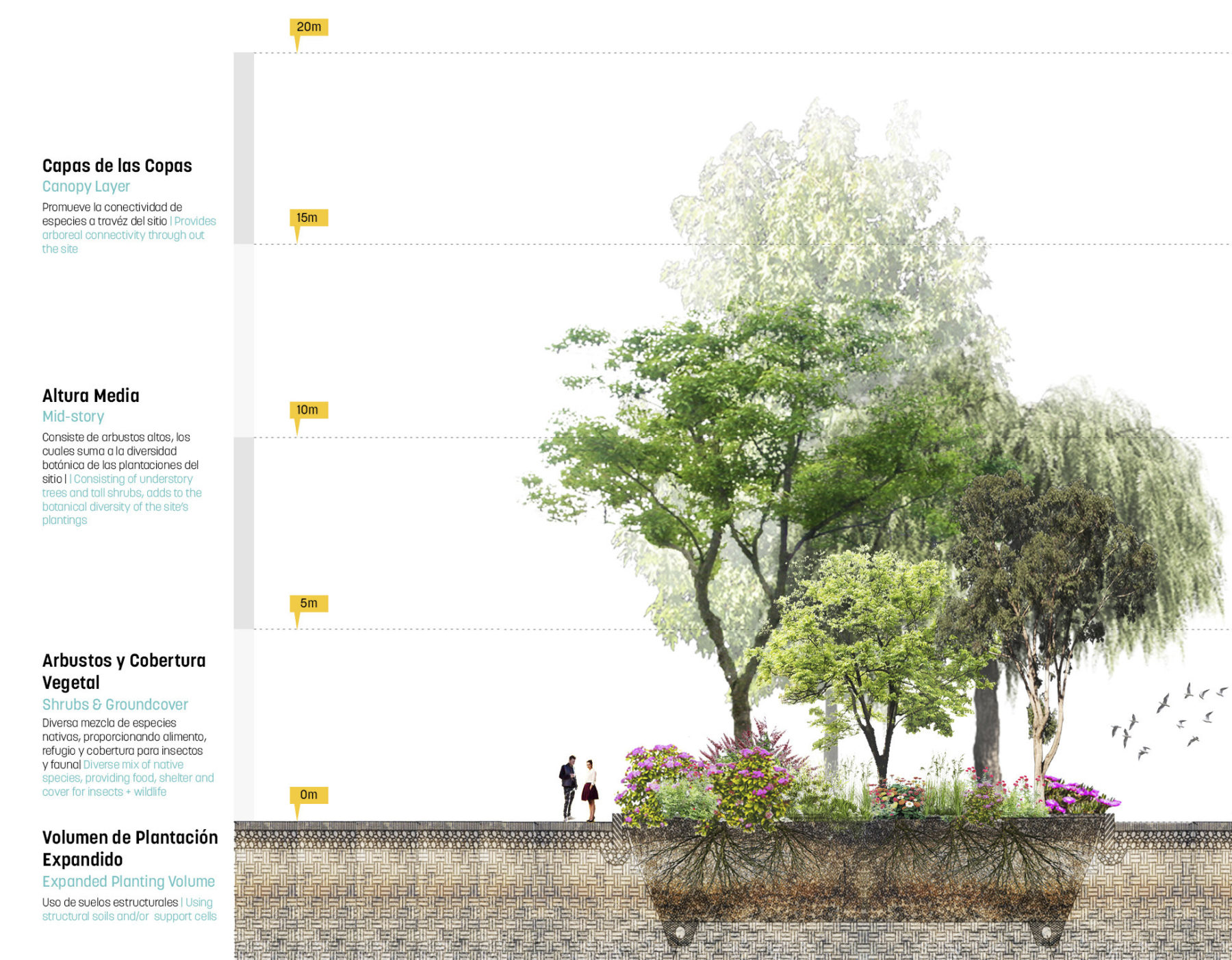
Street as corridors for habitat connectivity and ecological function
Diversity of vegetation
In-depth research of the Chilean coastal landscape informed strategies to regenerate the site’s ecological function and essential services
A system of Ecological Corridors and Stepping Stones provides strong connectivity between the escarpment and coastal habitat nodes
The Ladera (hillside) habitat is drawn into the neighborhood by a continuous tree canopy along Libertad Avenue. Green roofs and courtyards function as stepping stones between the escarpment and coastal landscape.
Streets as ecological corridors
Street as corridors for habitat connectivity and ecological function
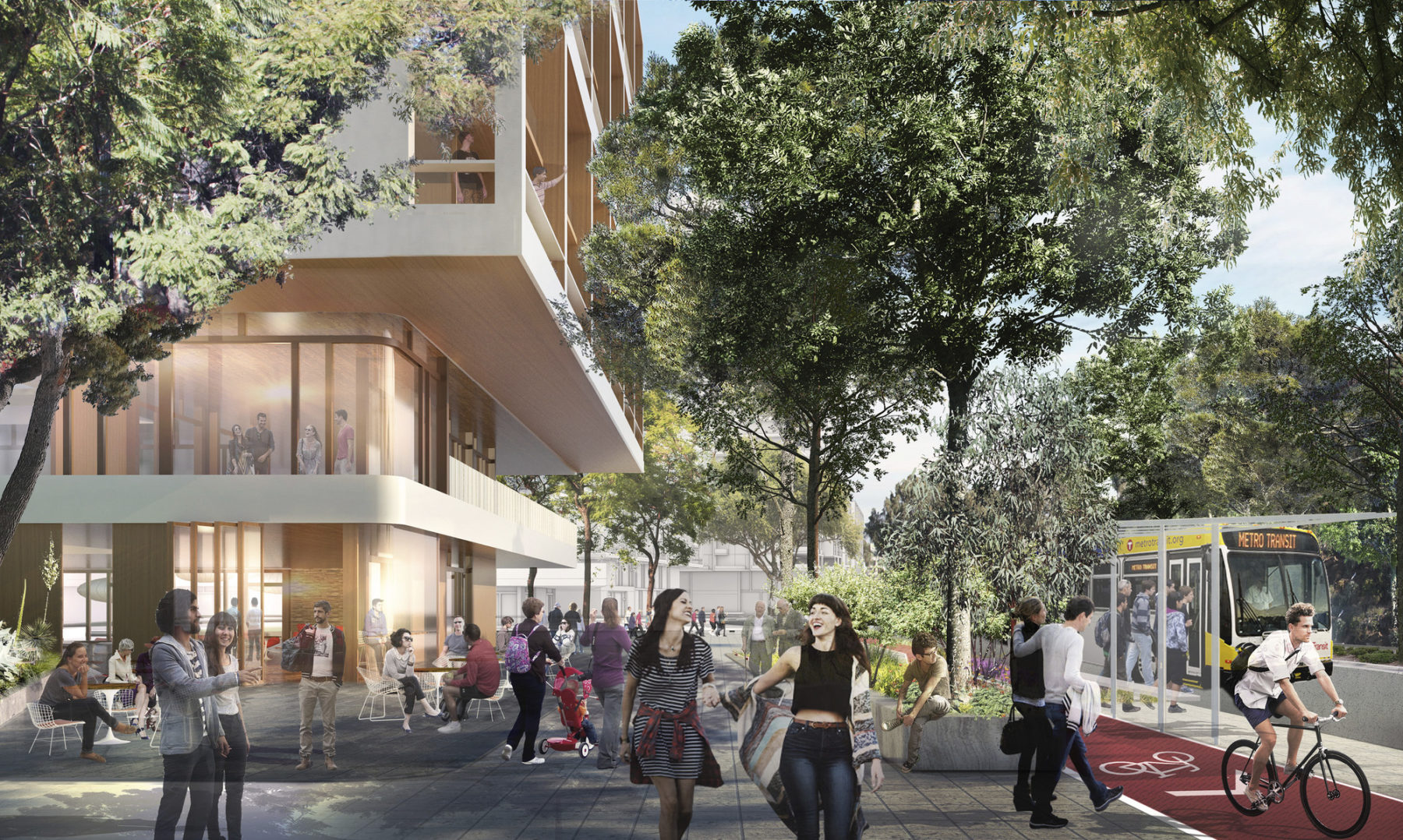
The landscape framework represents a departure from formal and monocultural boulevards by creating a biodiverse tree canopy
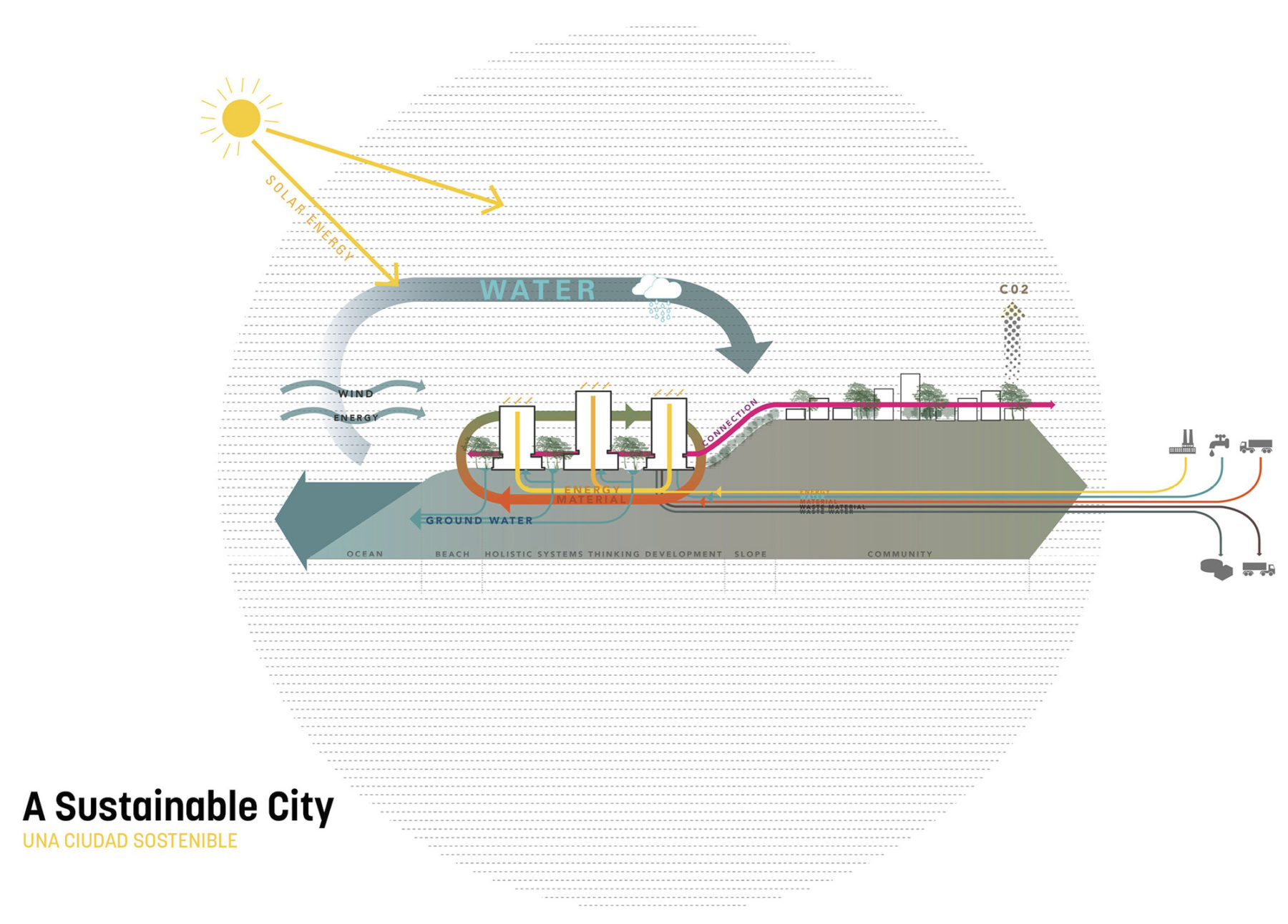
Sasaki’s multilayered approach to form and function takes into account connectivity and resilience of site systems, which in turn regulate stormwater, nutrients, carbon, microclimate, pollination, and species dispersal
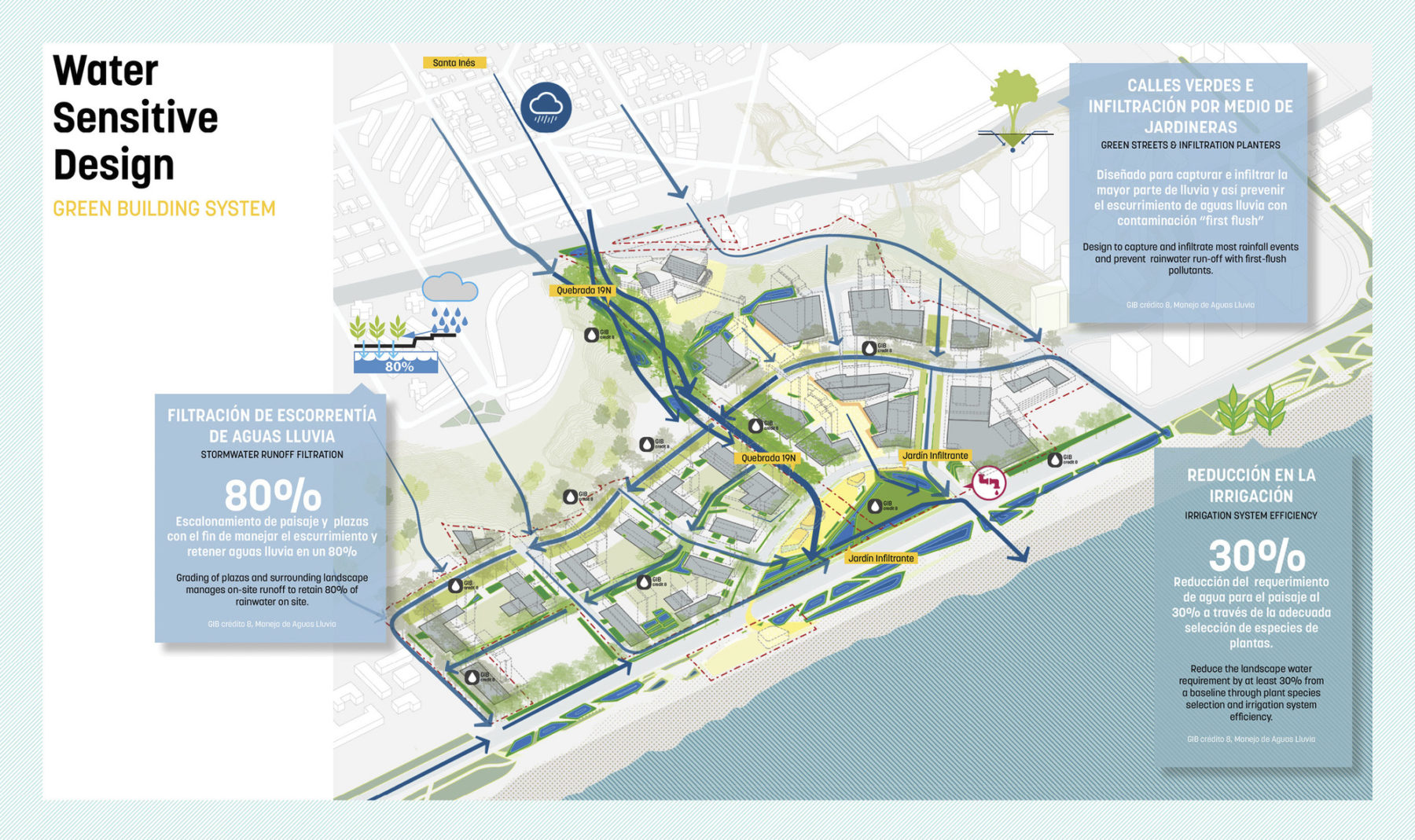
Climate change has led to a dramatic reduction in rainfall in coastal Chile. Water-sensitive design strategies reduce potable water demand, increase rainfall infiltration, and prevent saltwater intrusion of the coastal aquifer.
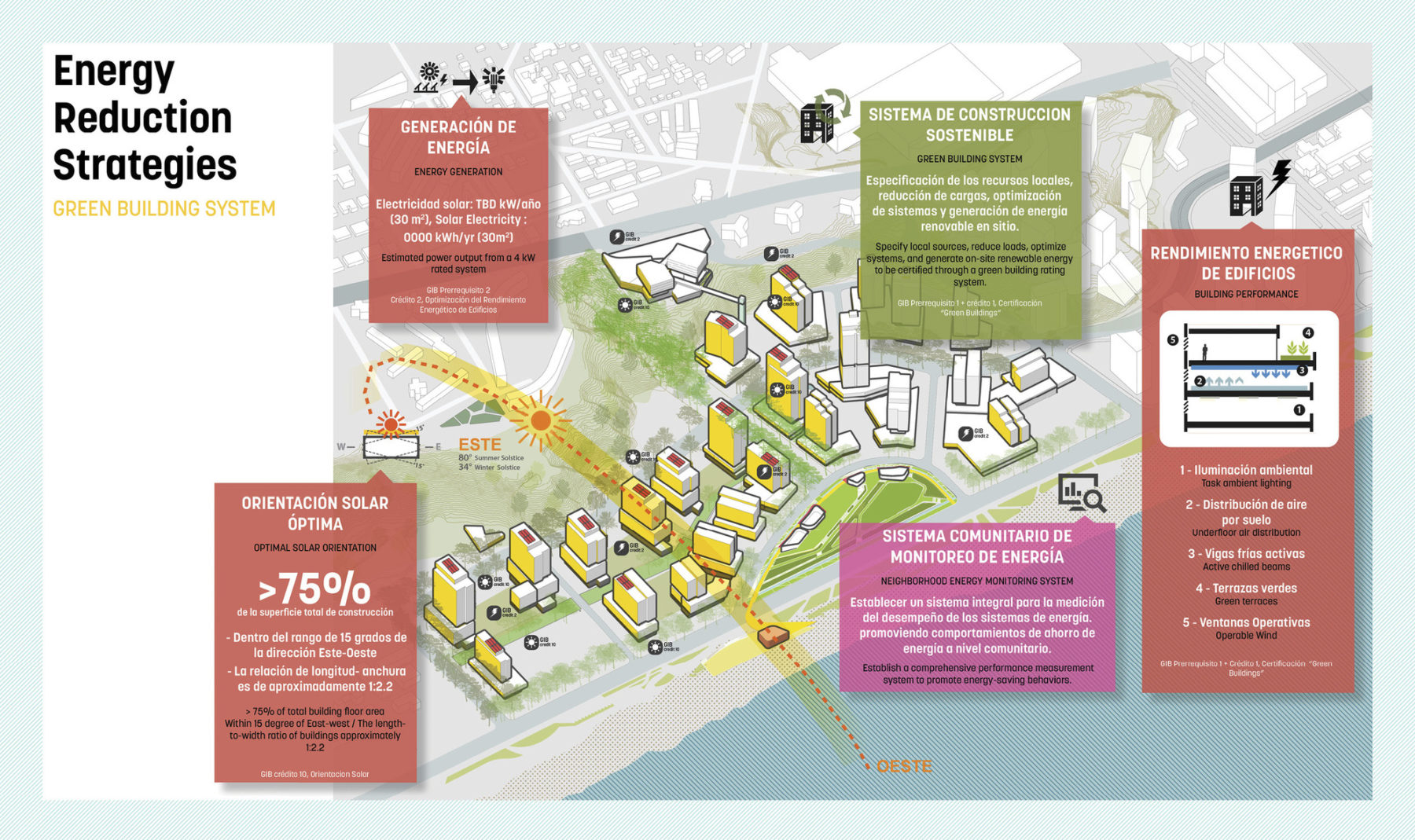
Orientation of buildings create a highly energy efficient urban form while design guidelines define performance parameters for future development. An energy monitoring system will be implemented at the district level to promote behavioral shifts for energy savings.
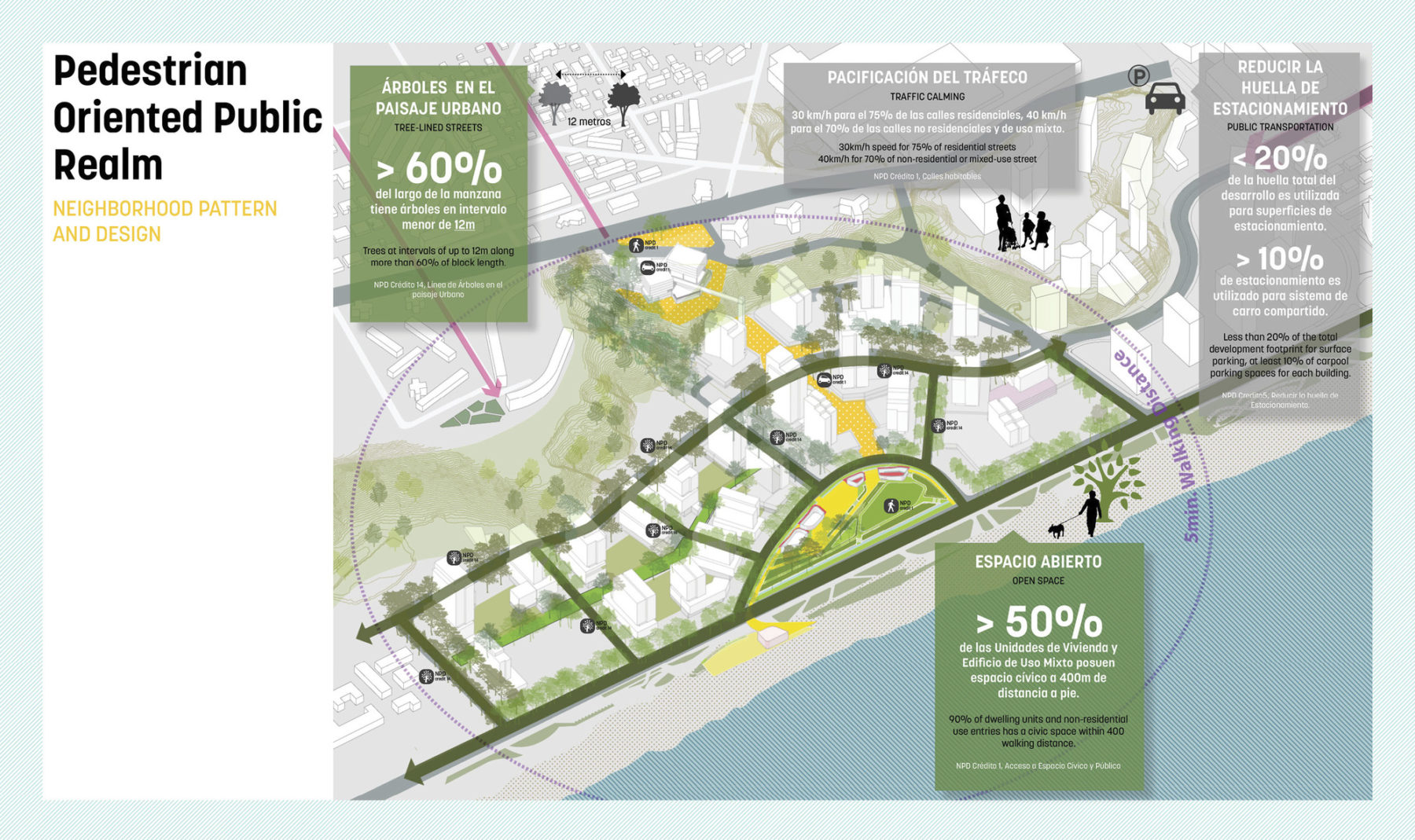
Pedestrian-oriented public realm
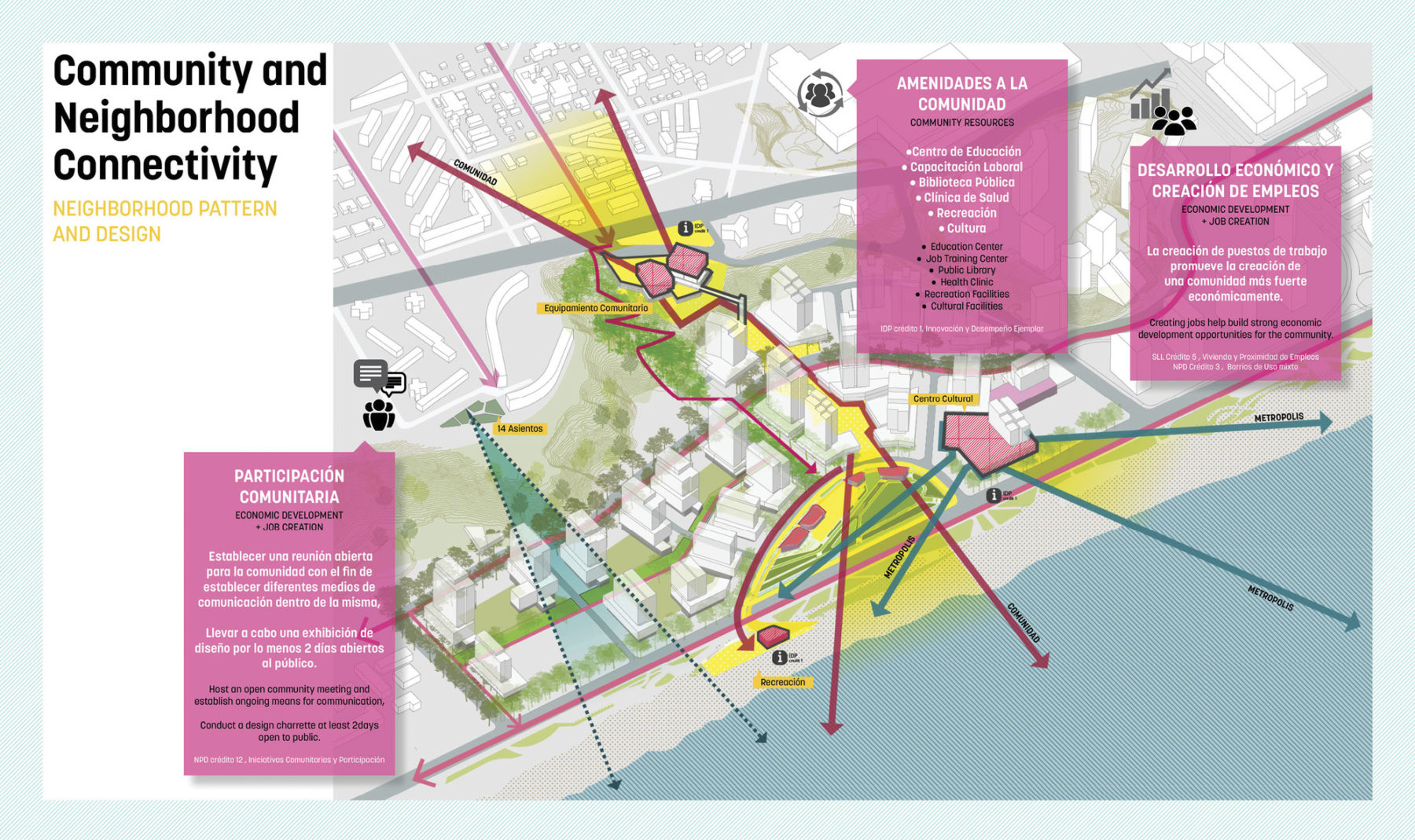
Community, neighborhood, and connectivity
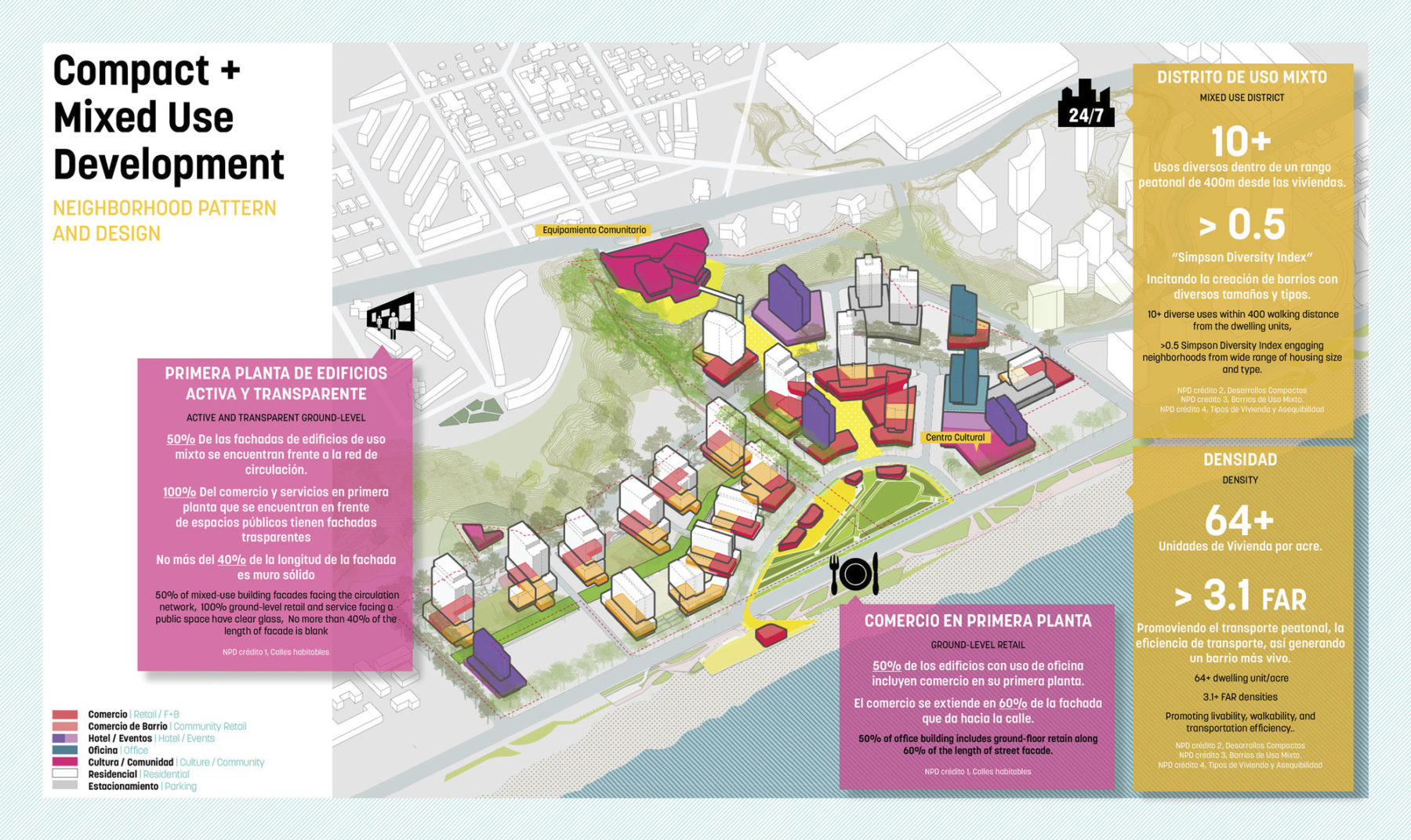
Compact and mixed use development
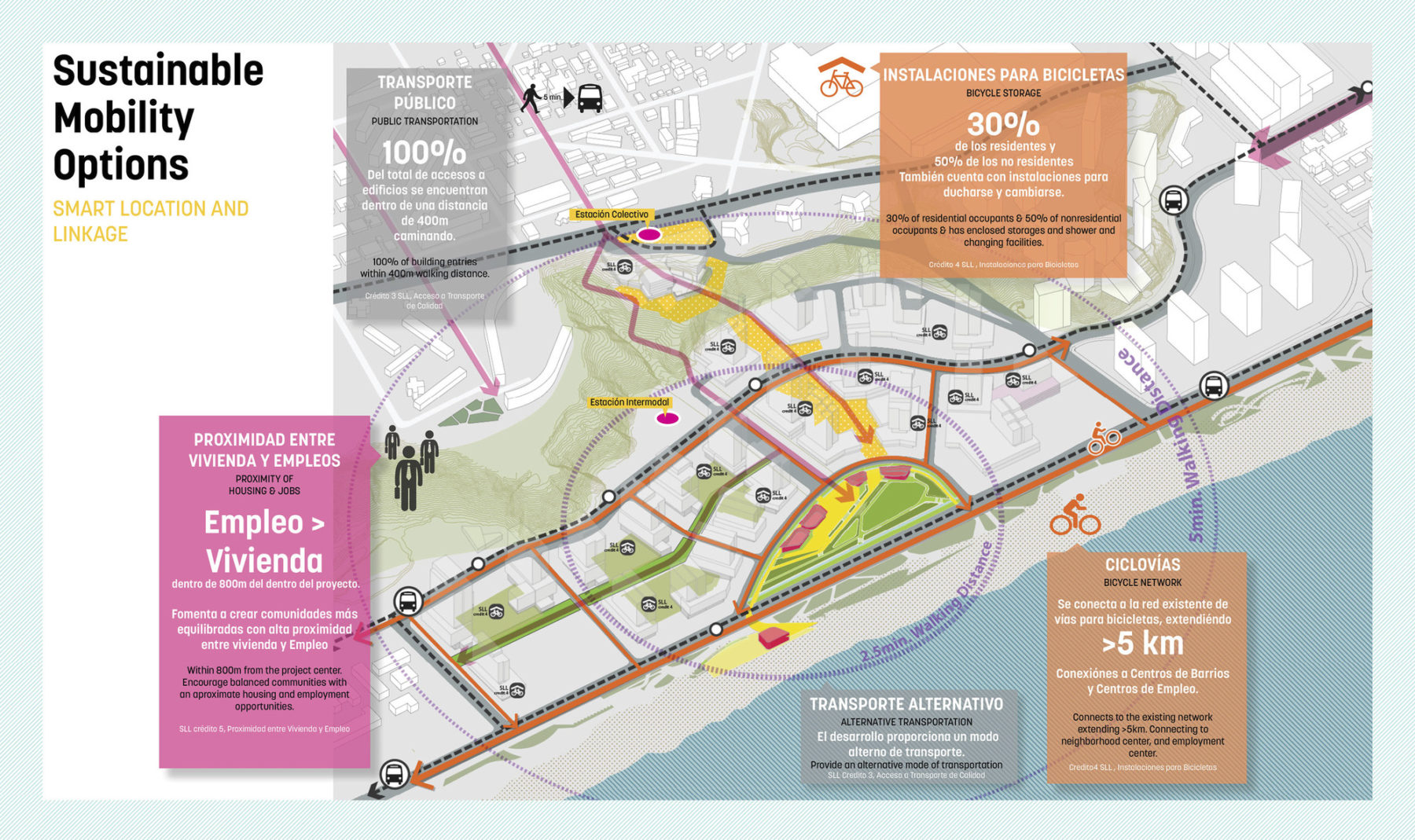
Sustainable mobility options
Sasaki’s multilayered approach to form and function takes into account connectivity and resilience of site systems, which in turn regulate stormwater, nutrients, carbon, microclimate, pollination, and species dispersal
Climate change has led to a dramatic reduction in rainfall in coastal Chile. Water-sensitive design strategies reduce potable water demand, increase rainfall infiltration, and prevent saltwater intrusion of the coastal aquifer.
Orientation of buildings create a highly energy efficient urban form while design guidelines define performance parameters for future development. An energy monitoring system will be implemented at the district level to promote behavioral shifts for energy savings.
Pedestrian-oriented public realm
Community, neighborhood, and connectivity
Compact and mixed use development
Sustainable mobility options
A network of verdant and functional public spaces ties the neighborhood together. Parallel to Libertad Avenue, a Linear Park with a combination of playscapes and seating terraces draw the community to the public realm, while providing mid-block pedestrian connectivity from predominantly residential areas to the social heart of the neighborhood.
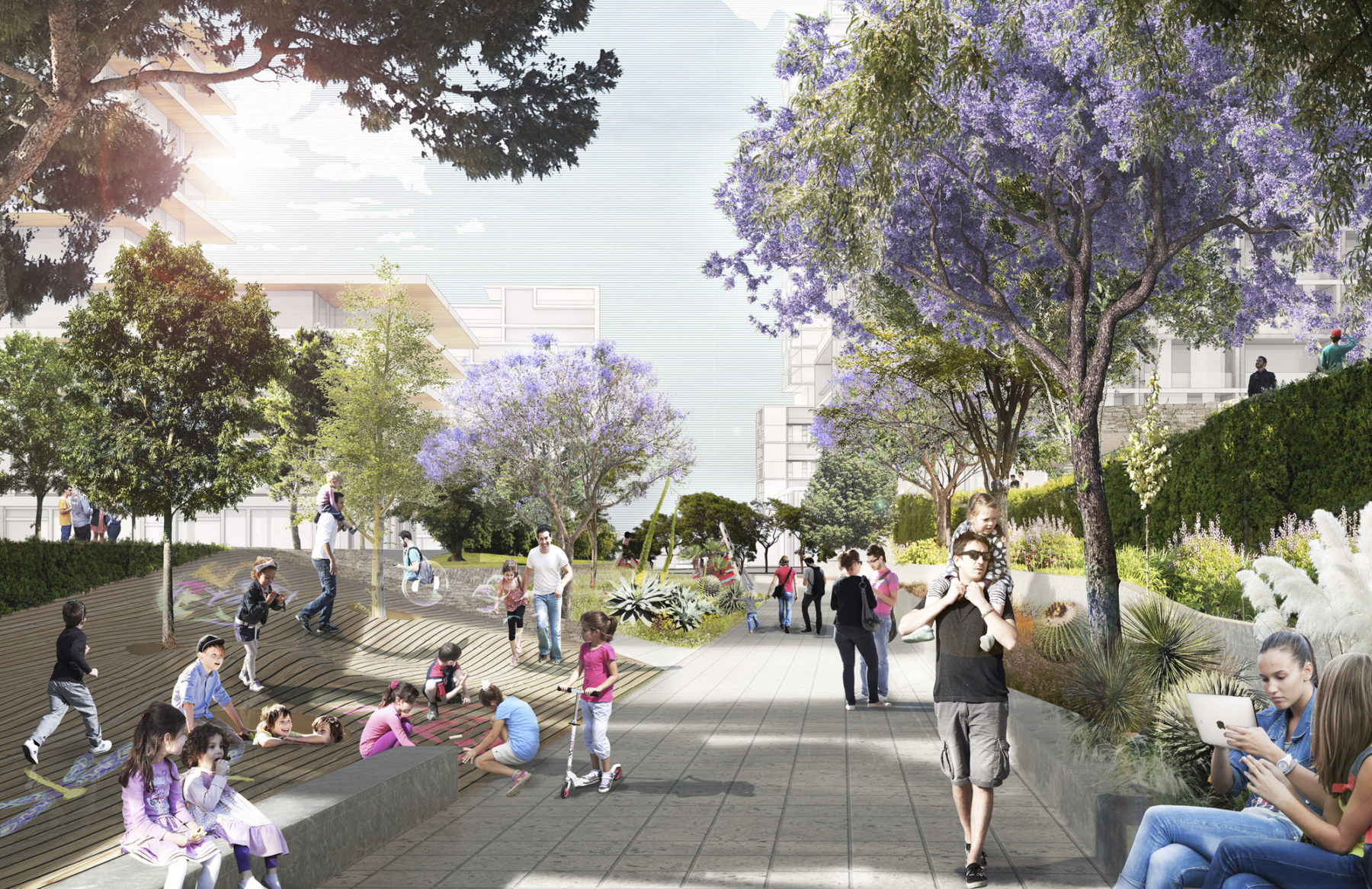
A park is envisioned as a social connector
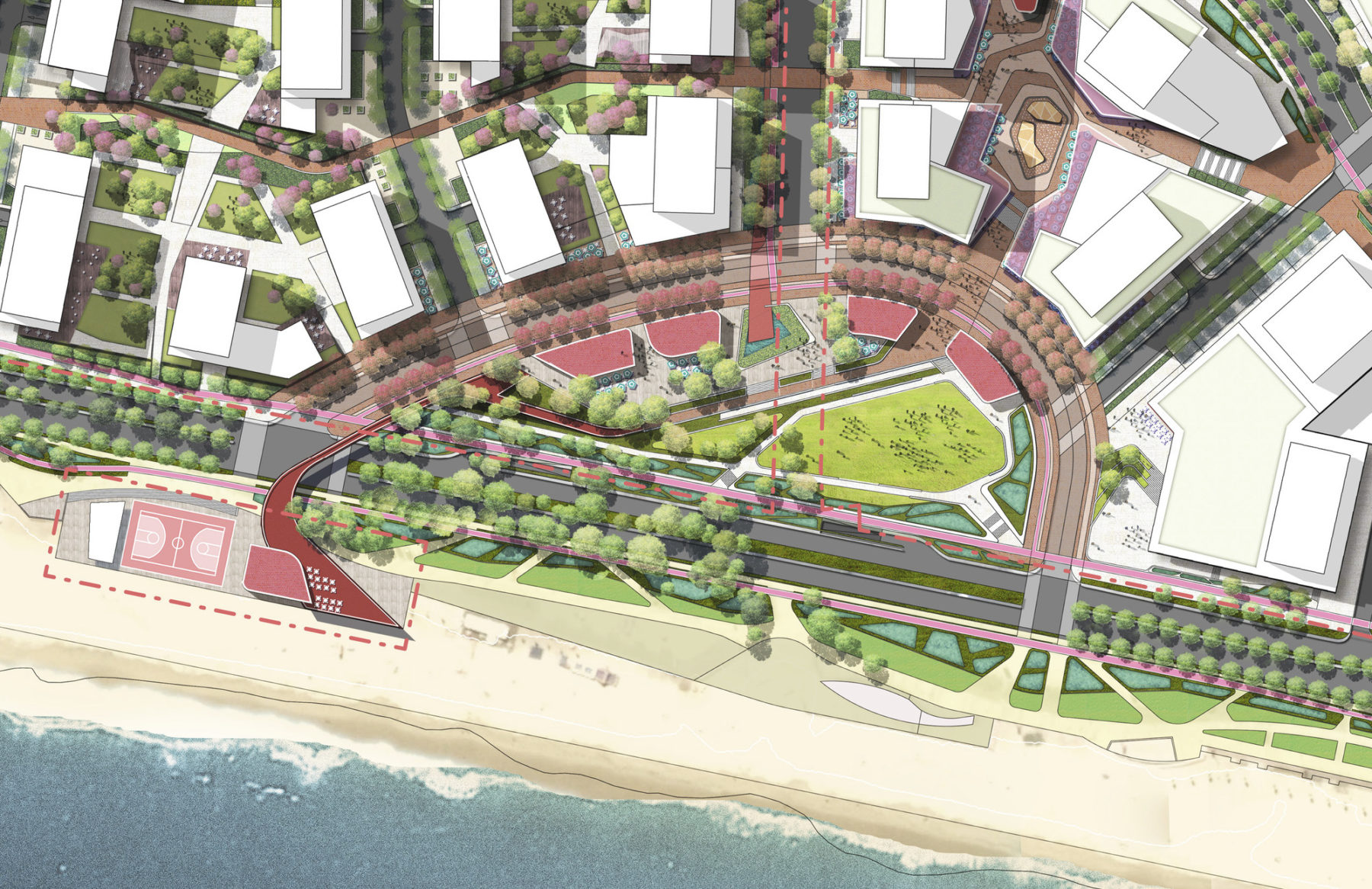
Public uses along the waterfront democratize access for communities long-separated from the water’s edge
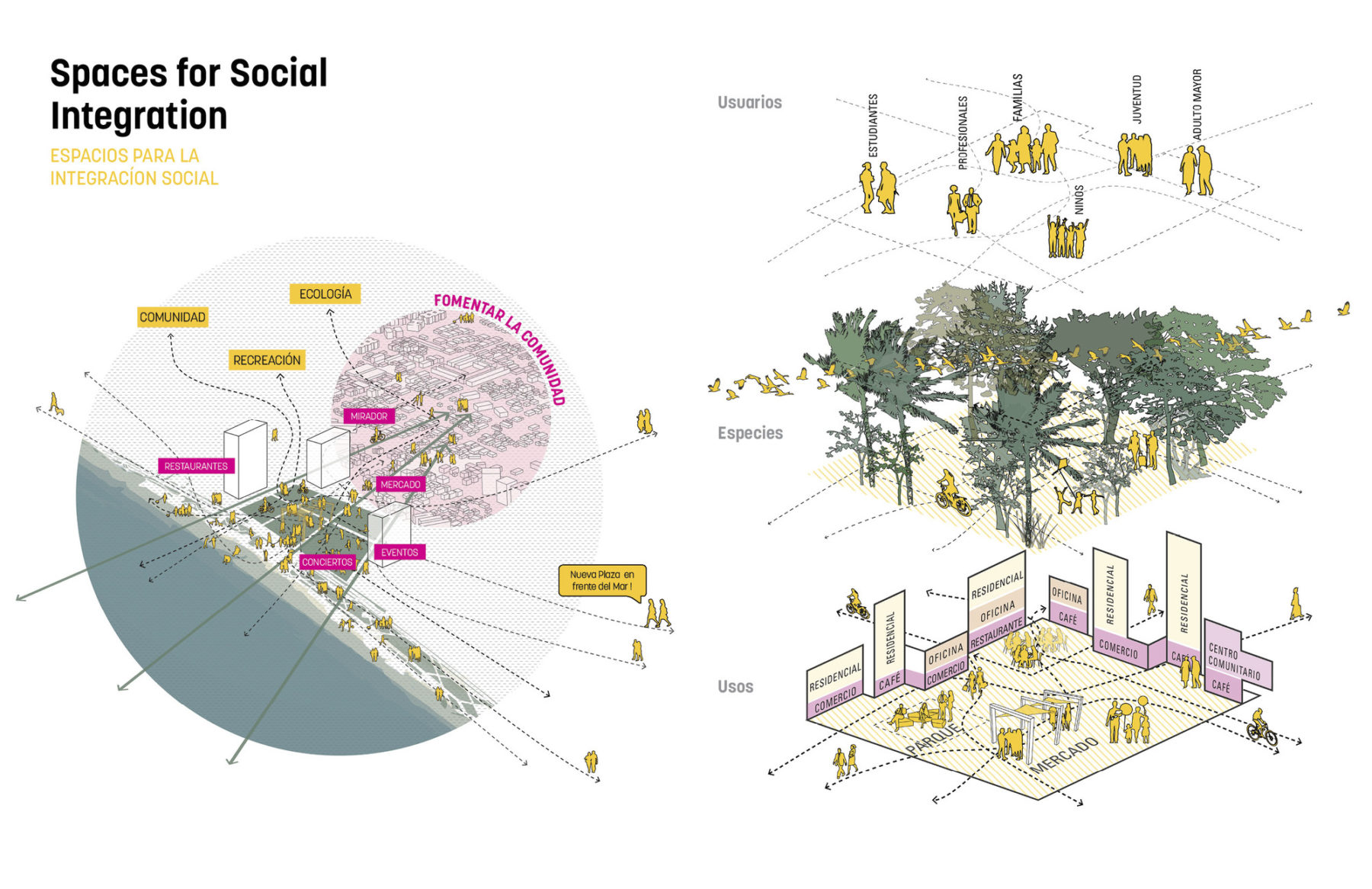
An exploded diagram of spaces designed for social integration
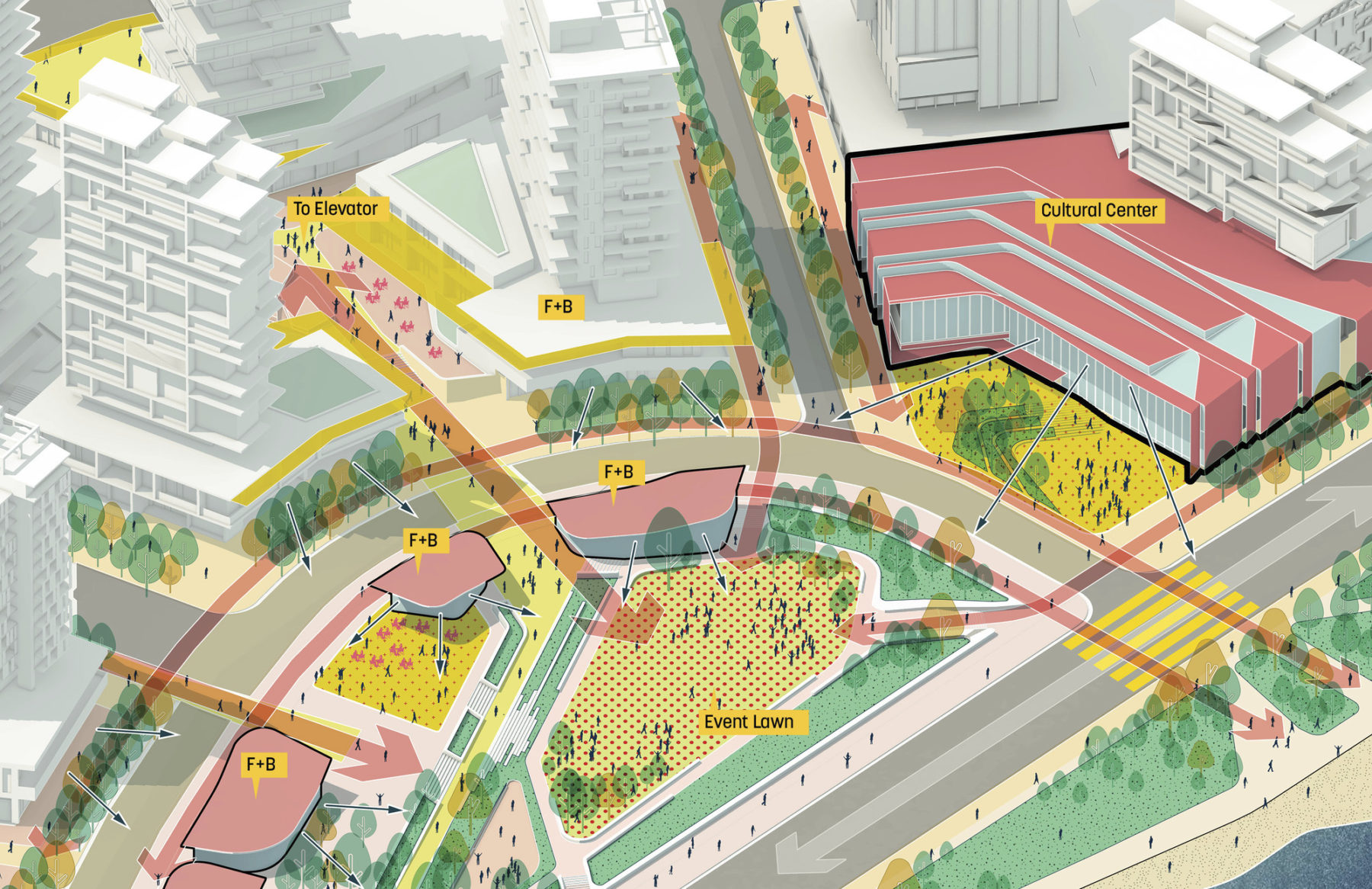
Framed by retail and cultural uses, the Central Park is able to host a range of civic activities that bring together the community of Viña. Cascading terraces create a neighborhood resilient to coastal storm surges.
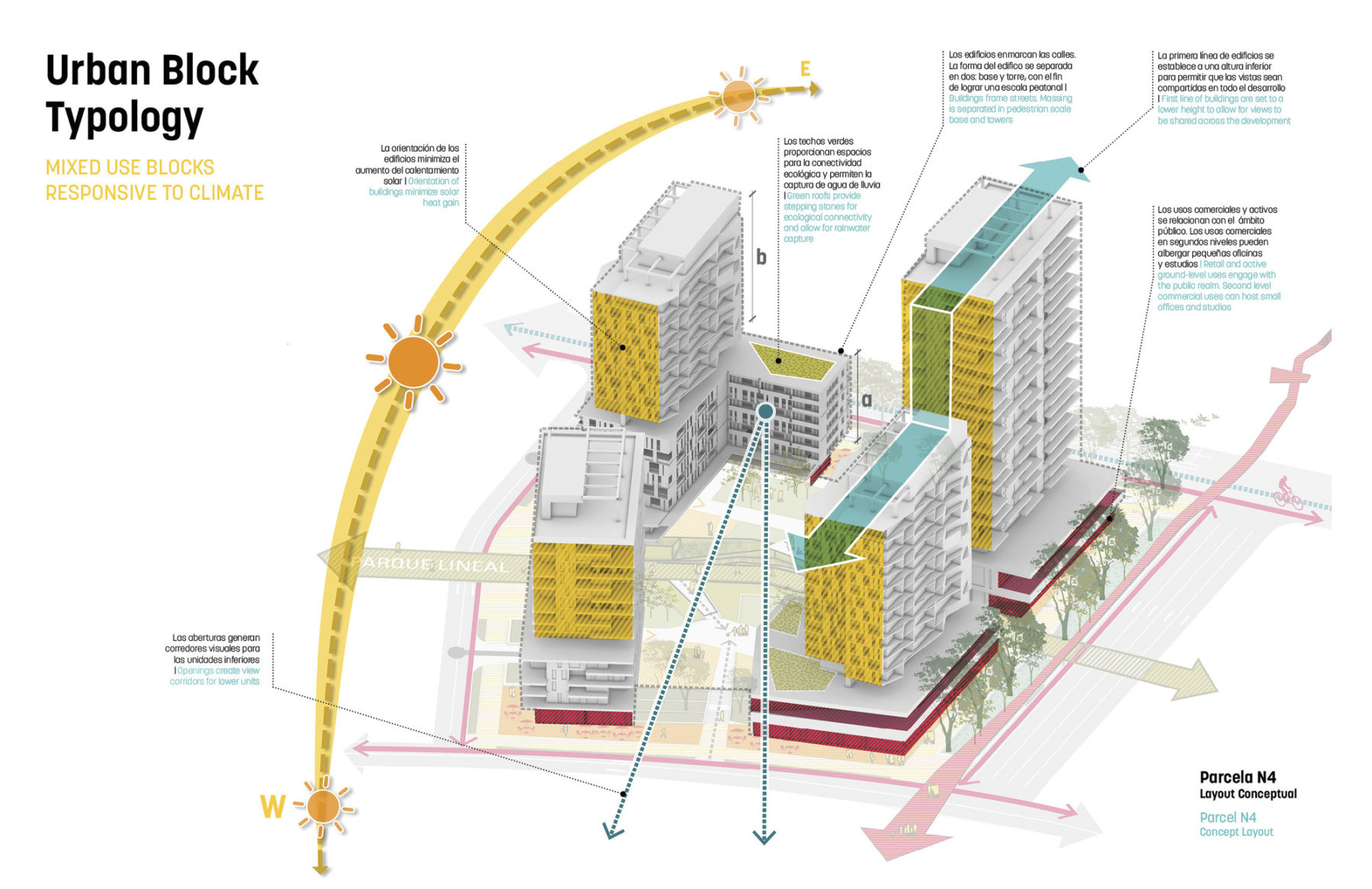
Mixed-use block typologies
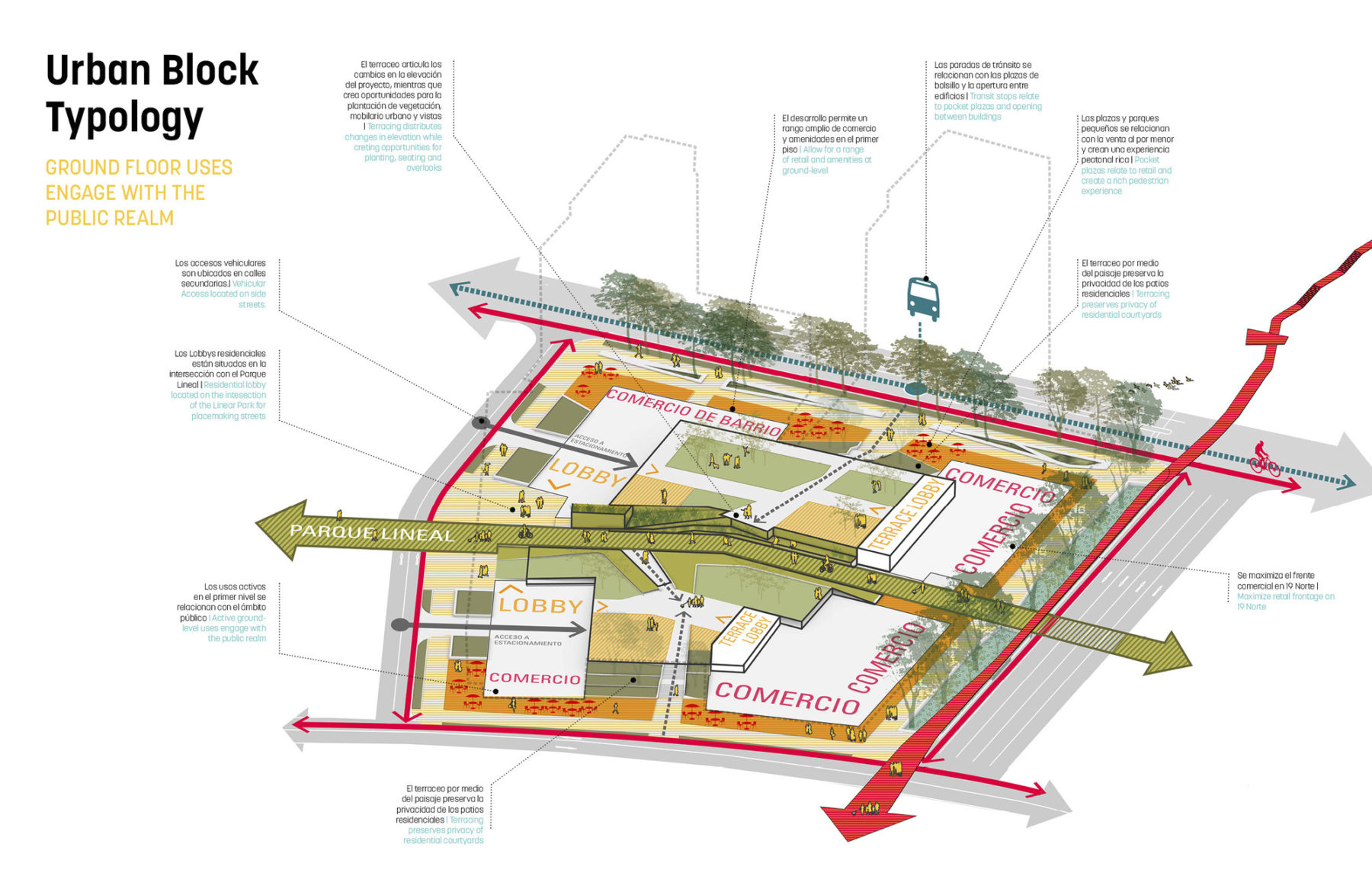
Program at the street level
Public uses along the waterfront democratize access for communities long-separated from the water’s edge
An exploded diagram of spaces designed for social integration
Framed by retail and cultural uses, the Central Park is able to host a range of civic activities that bring together the community of Viña. Cascading terraces create a neighborhood resilient to coastal storm surges.
Mixed-use block typologies
Program at the street level
An unprecedented and ongoing engagement process energized the people of Viña around the opportunities for renewed life in the city. Over a series of “Urban Dialogues”, the design team, public officials and the community exchanged ideas and engaged in systemic thinking on how to improve the quality of life in Viña and its larger context. A shared commitment to create a legacy project emerged, creating the foundation for a visionary, resilient and sustainable framework for the evolution of the site and city as a whole.
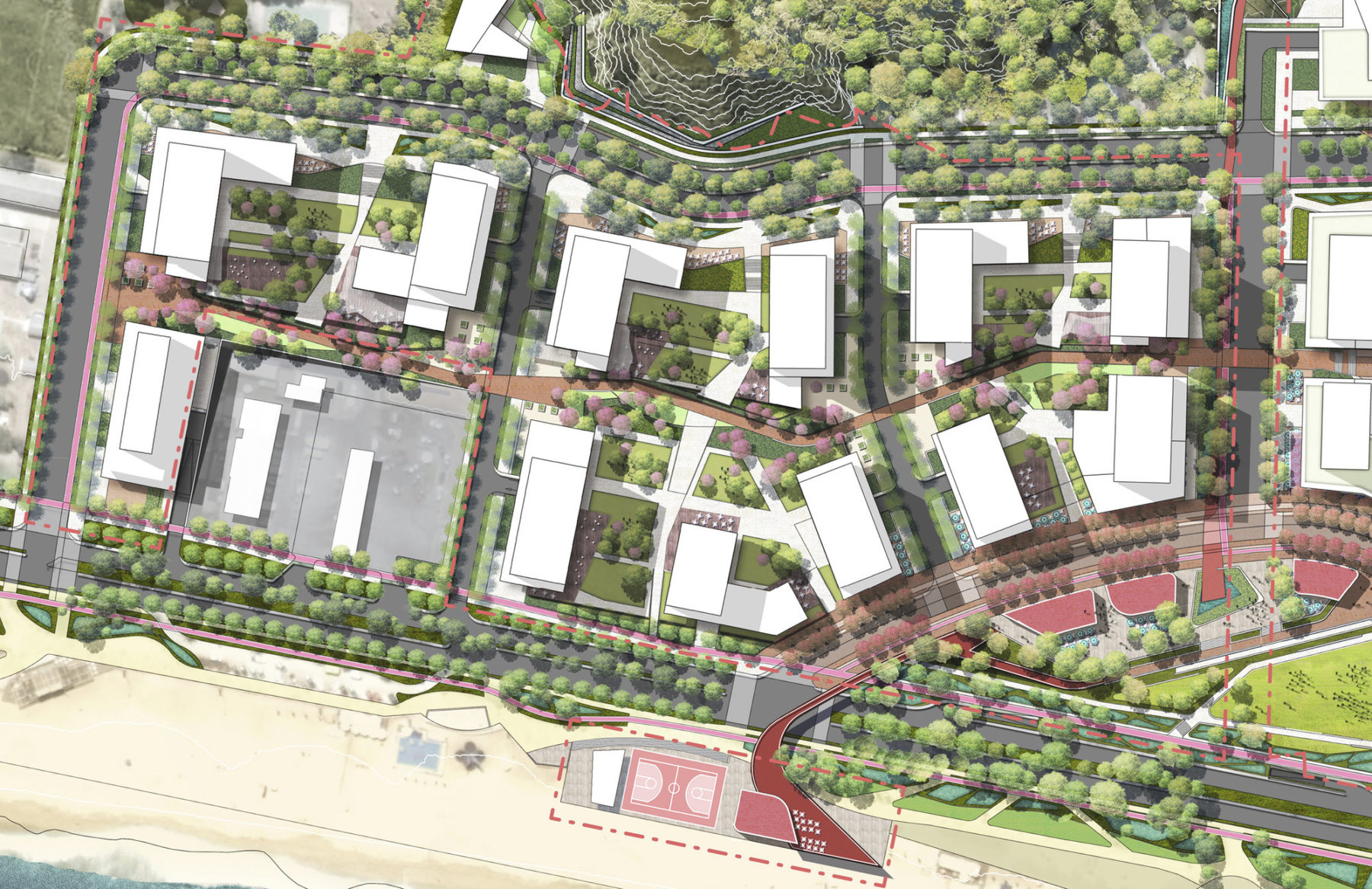
Plan detail
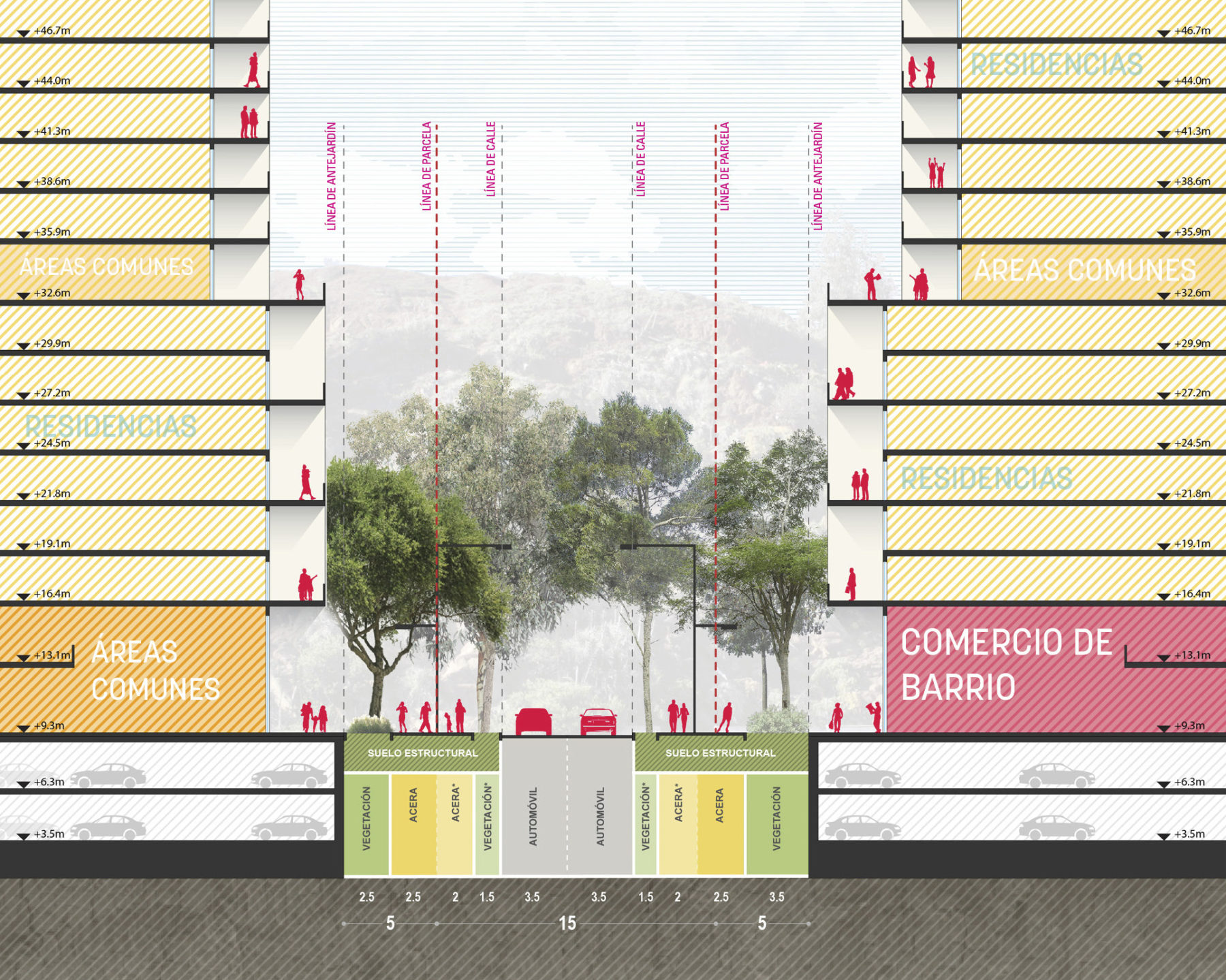
Street design
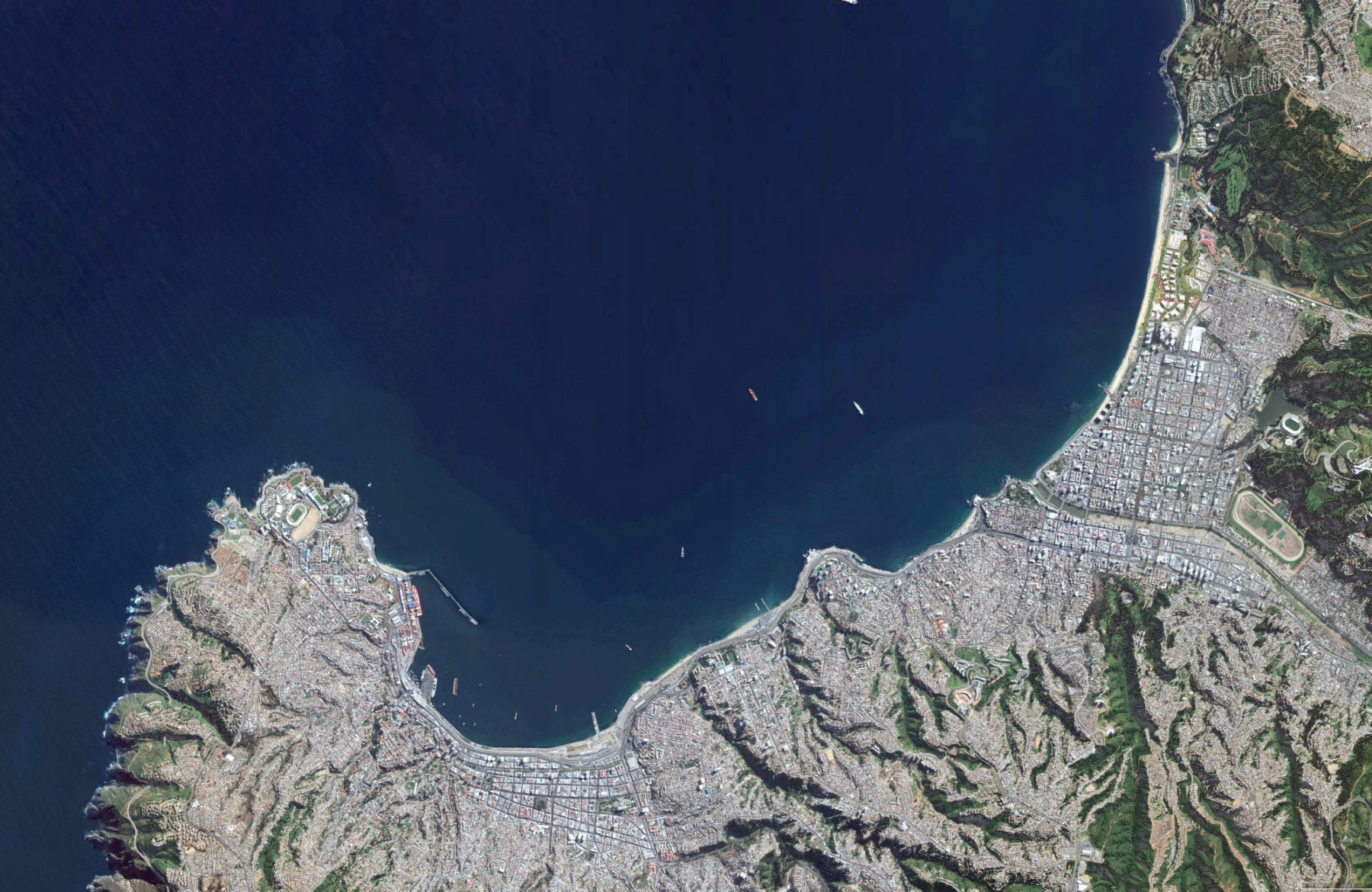
Las Salinas is redefining the trajectory of Viña, re-engaging the city with its social and ecological context
For more information contact Dennis Pieprz.

